
|
|
Artist Index
Rembrandt, With a Complete List of his Etchings
Arthur M. Hind 1912  Illustrations
REMBRANDT[pg 5]
Rembrandt Harmensz van Ryn, son of Harmen Gerritsz van Ryn, miller (d. 1630), and Neeltge Willemsdochter (d. 1640), daughter of a baker of Zuytbroeck; born at Leyden, July 15, 1606; entered Leyden University as a student of letters, May 20, 1620, but left before the end of the year; studied painting for about three years in his native town under Jacob Isaaksz van Swanenburgh, and at the age of seventeen for about six months under Pieter Lastman in Amsterdam; settled in Leyden from 1624 until 1631, removing with his sister Lysbeth to Amsterdam in the latter half of 1631; married Saskia van Ulenburch, June 1634; from 1639 to 1658 lived in the Breestraat (in the house which is now open to the public); lost his wife in 1642; from about 1652 Hendrikje Stoffels, who had been his servant, lived with him as his wife, until her death about 1664; Rembrandt's material success as a painter was counterbalanced by his zeal for collecting works of art, and in 1656 he was forced by his creditors to declare bankrupt; an inventory of the contents of his house, made in view of the sales which took place in 1657 and 1658, is still preserved; the last part of his life was spent in a lodging on the Rozengracht, and all the money that he earned went to his creditors whom he never satisfied; he died and was buried in the Westerkerk, Amsterdam, October 4, 1669.
The formal style of art, the essence of line-engraving, reached its zenith in Albrecht Dürer. And Dürer was so great a master that human feeling told through the medium of the severest formalism. But it was not till a century later that human expression found its full outlet in an artist whose sympathy was at once penetrating and comprehensive, who perfected a medium capable of the most spontaneous rendering of the deepest as well as the most fleeting emotions of life. As a painter Rembrandt was chiefly devoted to portraiture, a devotion no doubt largely due to the conviction that its study gives the most immediate opportunity for depicting human character. [pg 6] But it must also be confessed that the overwhelmingly large proportion of portraits to other subjects in his painted work may be partly owing to the demands of clients. That it was not entirely so is immediately evident when one considers the master's untiring industry in painting portraits of himself after his popularity had waned, and commissions nearly ceased. Nevertheless as works for the most part uncommissioned and less lucrative than the paintings, we may take it that the etchings are a true reflection of the actual tendency of Rembrandt's genius when least affected by demands from outside. In his etched work we find that portraits are much less numerous, and by far the largest place is given to the subjects from scripture, treated with the same reality that characterises his sketches from daily life. Rembrandt's affection for scriptural subjects is a striking fact in face of the general character of Dutch art in the seventeenth century. The reformation in Holland seems to have helped towards the exclusion of art from the domain of religion; and the merely formal and superficial rendering of biblical stories by the classicists of the late sixteenth century may have also had much to account for the secular reaction of the succeeding period. But Rembrandt had no need to seek new ground to escape from a formal rendering of well-known themes. Like most masters of supreme genius, his originality consisted in the realisation of his own deepest and most personal emotion in his treatment of the old stories. They appealed to him as the vehicle of the noblest thoughts of man in relation to himself and God, and he was practically the first artist who dared approach the Scriptures in the spirit of reality that implied a living faith rather than an official creed. It is perhaps still not superfluous to emphasise the fact that the etchings of Rembrandt (as of nearly all the painter-engravers or etchers) are original works distinct in methods and aims from the paintings or works in any other medium. In Rembrandt's work of rather more than three hundred etchings there are scarcely half a dozen subjects that correspond with his pictures. In general the original engraver or etcher conceives and carries out his design in specific relation to its medium; its expression in another would demand an entirely different treatment. Rembrandt worked on copper in pure etching and dry-point. In pure etching the plate is first covered with a thin layer or ground of wax composition; the etcher draws through this ground (which offers scarcely any resistance) with an etching needle, opening up the [pg 7] surface of the copper where he wishes his lines to appear. The plate is then put in a bath of acid which bites the furrows in the unprotected parts of the plate, i.e. wherever the needle has been drawn through the ground. Dry-point, though generally regarded as a branch of etching, as it is so constantly used on the same plate as bitten work, is in reality more akin to line-engraving. No acid is used, and the lines are scratched on the surface of the copper by a strong steel point. The artist does not push this point before the hand like the graver, but uses it in the same way as a pencil. The curl of metal thrown up at the side of the line is not scraped away as in line-engraving, where the aim is clearness of designs, but left to hold the ink, enwrapping the line, as printed from the furrows, in a rich cloudy tone. This curl of metal, or “burr” (a term also applied to the velvety tone which it causes), is extremely delicate, and a comparatively few impressions suffice to level it with the surface of the copper, and leave the effect a mere ghost of the artist's intention. So that rich impressions from dry-points are infinitely rarer than good ones from the pure etchings, which often yield hundreds of prints without greatly deteriorating in quality. But the more delicate the etching and the closer the mesh of line, the sooner will deterioration of quality set in, so that a glance at the character of an etching, granting that the plate was not destroyed after a very limited issue, will almost immediately reveal one important point, i.e. the comparative rarity of good impressions. It is clear and strong open line prints such as the Christ at Emmaus of 1654 (282) of which moderate impressions are not so valuable, for such plates were still in fair condition for printing as late as the eighteenth century. Pure etching is often combined with dry-point, the latter being used to give emphasis and strength to an etching of greater uniformity of tone. Rembrandt did not begin to use dry-point until about 1639, e.g. in the Death of the Virgin (161), but it is not handled with any richness of effect until such works as the Triumph of Mordecai (172) which probably dates several years later. A print like the Three Trees (205) might seem from the reproduction to have the rich tone that comes from dry-point, but in this case the dark effect is almost entirely due to a close mesh of pure etched lines. The real quality of dry-point may be better studied in some of the lightly sketched lines in the foreground of the Artist drawing from a model (231), e.g. the palm branch on the right. In his early period up till about 1640, Rembrandt's etching is characterised by a clear lineal manner with little tendency to the [pg 8] chiaroscuro which gradually became the characteristic feature of his artistic style in etching as well as in painting. Later he tends to a greater breadth of treatment in line, and a less imitative treatment of physical form. At first his experiments in chiaroscuro were produced by the close mesh of etched lines, but it must be confessed that etching as such rather loses its character when the line is so entirely lost in tone. Even the Hundred Guilder Print (236) holds its unrivalled place in the art of etching rather for the genius that overcame supreme difficulties than for the supreme fitness of the style in relation to the medium. Rembrandt never showed the breadth of his sympathy and his powers of observation better than in this plate, but for grandeur of conception, concentration of material, and a vigorous handling more in keeping with the scale of his subject, he attained a nobler—I think his noblest—creation in the Three Crosses (270). The changes introduced in this plate in a later state are remarkable, and show how completely the etcher can transform his subject. Here the changes are astonishingly drastic, and may have been intended to direct us to an entirely different moment in the drama of the Crucifixion. In other examples, such as the Christ presented to the People (271) and the Landscape with trees, farm-buildings, and a tower (244), one sees how Rembrandt was constantly striving in the progress of his states towards greater concentration of idea, effecting it in the former by the removal of an entire group of figures, in the latter by the lopping of a cupola on the church tower. Except for an occasional plate like the Clement de Jonghe (251) with its open line after the manner of Van Dyck, Rembrandt kept to the method of close painter-like shading throughout the latter part of his life, but in his subject prints he almost entirely discarded this method of chiaroscuro for a more luminous and mysterious shadow effected by the surface tinting of a more broadly etched plate. The various states of the Entombment (281), first with the line quite open, then with some added shading partially aided by a surface tint, exemplify the manner of his progress. In this wonderful plate, and nearly all the subjects of his later period, Rembrandt had attained a dignity of composition which we find in few painters outside Venice. In spite of his thoroughly Dutch temperament, Rembrandt had learnt much from the Italians, and in nothing more than in space composition. A very large proportion of his early etchings are studies of seperate figures. Only by this constant study of pieces of life was perfected the power by which his greater conceptions were realised with such unity of effect. [pg 9]Rembrandt took longer than many a weaker artist to reach his maturity, not that his progress was slower, but the maturity much higher, and even his old age seemed like youth in its perennial receptivity and power of vigorous growth. A well-known connoisseur of the time, Constantin Huygens, writing in 1631, was more impressed by Lievens's brilliant flights of invention than by Rembrandt's vivid power of expressing character and emotion. But while the former and so many of his contemporaries were content with their own facility and the convention they had reached, Rembrandt never remitted the ardour of the great quest which was the very blood of his life. Constantly breaking new paths, and losing at each new turn his earlier patrons, who failed to follow the progress of his genius, he died in comparative neglect, only to be rediscovered by the moderns as one who still belongs to the most living style of art. A few etchers of the last two or three generations have taken a step further or aside in this or that direction, more particularly in the art of landscape, but even Whistler, at once the supreme virtuoso and the greatest individuality of nineteenth-century etching, falls far short of Rembrandt in the one thing which makes or mars genius of the highest order, i.e. depth of humanity, without surpassing him in the technical mastery of expressive line. Rembrandt remains for us the greatest etcher who has ever lived, as well as one of the noblest exponents in art of the deepest and most generous emotions of life. BOOKS OF REFERENCECATALOGUES
GENERALAlso including the most important works on Rembrandt's paintings and drawings
A CHRONOLOGICAL LIST OF REMBRANDT'S ETCHINGSArranged according to the author's complete catalogue in Rembrandt's Etchings, an Essay and a Catalogue (Methuen, 1912), which follows the chronological arrangement of the collection in the British Museum. Numbers that are obelised (†) are plates of doubtful authenticity; starred numbers (*) refer to plates not represented in the British Museum. Conjectural dates are cited within brackets. Except for Nos. 144 (frontispiece), 139 and 164 (on same plate as No. 40), and 196 (on same plate as No. 175), the etchings reproduced (entirely from the British Museum collection) are given in the order of this catalogue, so that plate numbers have been dispensed with. The Roman numerals following the catalogue numbers in the underlines to the plates refer to the states of the etchings as described in the complete catalogue. B. = Bartsch.
The title-page border is taken from a portrait etching by Juriaen Ovens, of Frederick III of Holstein Gottdorp.
[pg 21]
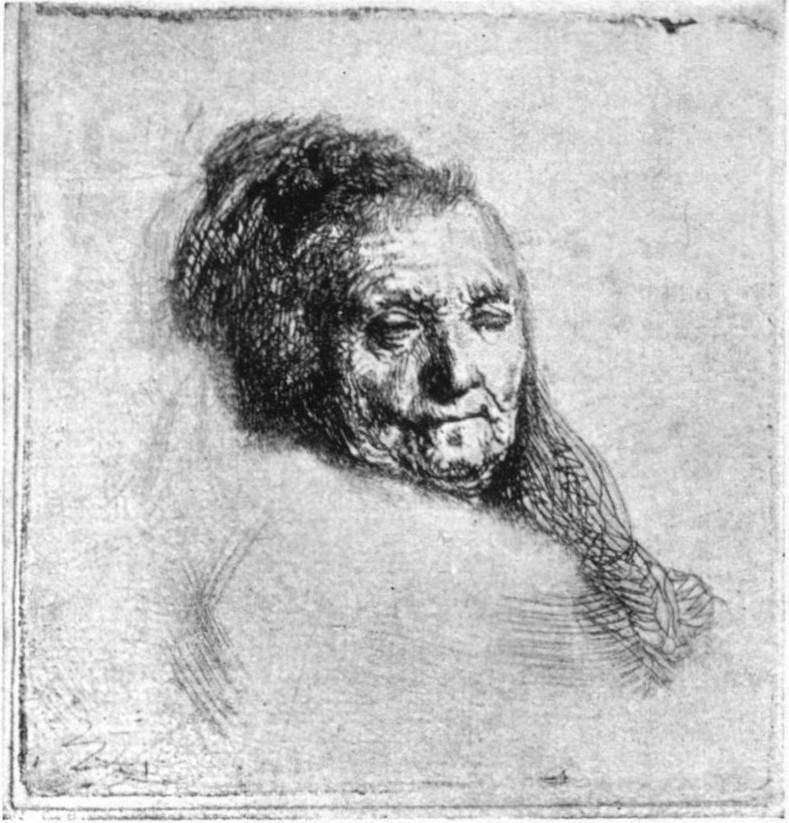
1, I. REMBRANDT'S MOTHER, Unfinished state. 1628: B. 354.
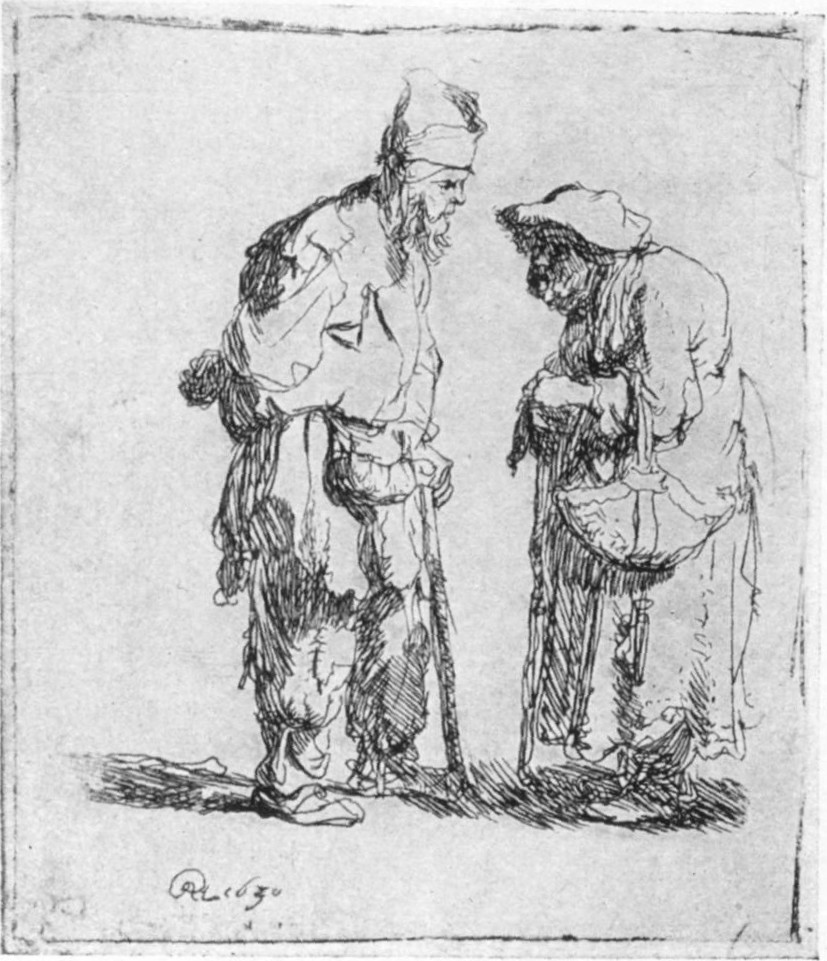
7, I. BEGGAR MAN AND BEGGAR WOMAN CONVERSING. 1630. B. 164
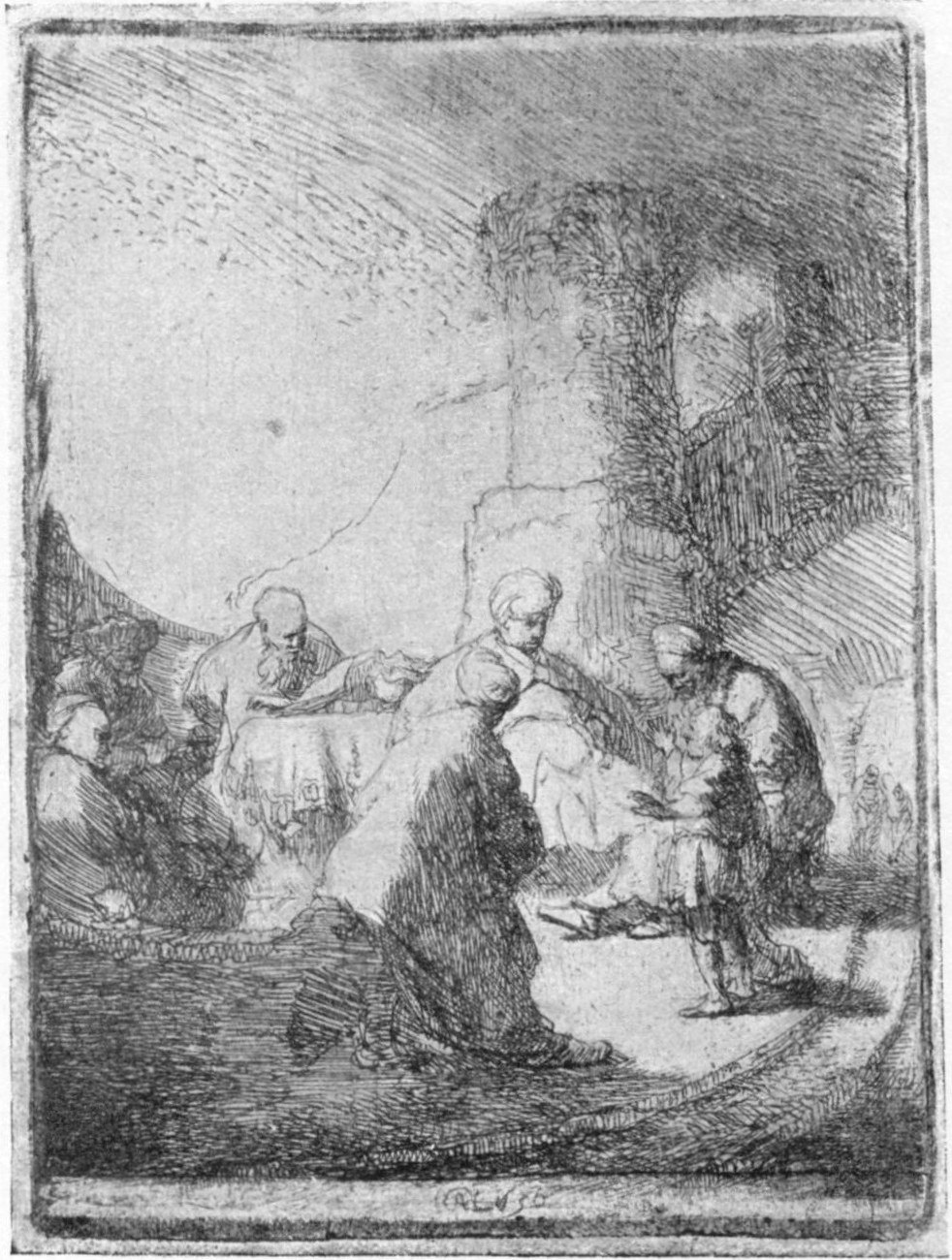
20, I. CHRIST DISPUTING WITH THE DOCTORS: SMALL PLATE. 1630. B. 66

23, I. BALD-HEADED MAN (REMBRANDT'S FATHER?) In profile r.; head only, bust added afterwards. 1630. B. 292. First state, the body being merely indicated in ink
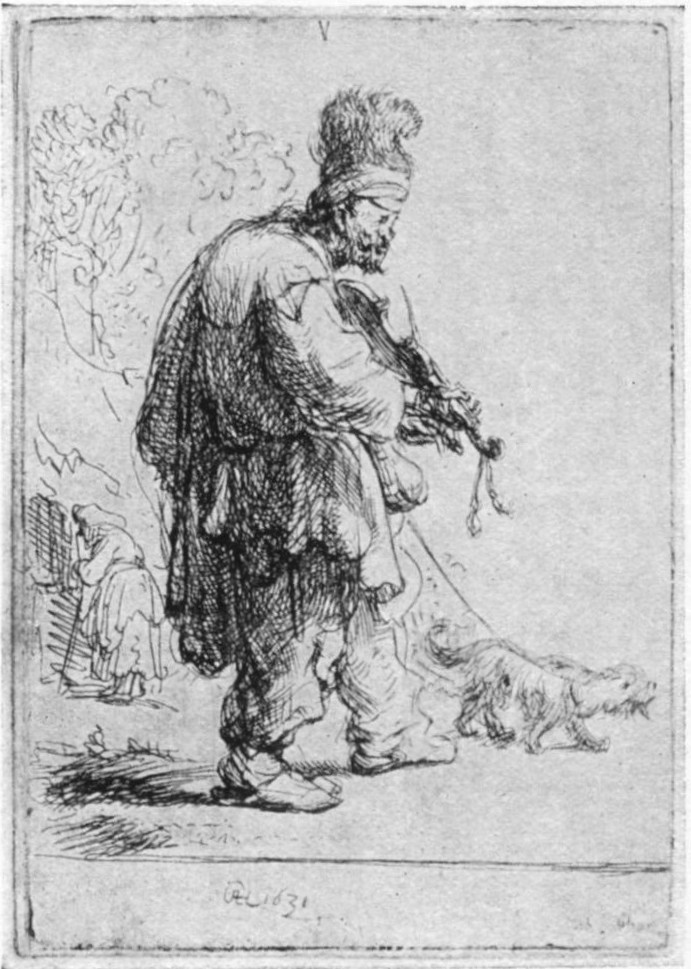
38, II. THE BLIND FIDDLER. 1631. B. 138

40. THE LITTLE POLANDER. 1631. B. 142. 139. THE QUACKSALVER. 1635. B. 129. 164. A PEASANT IN A HIGH CAP, STANDING LEANING ON A STICK. 1639. B. 133
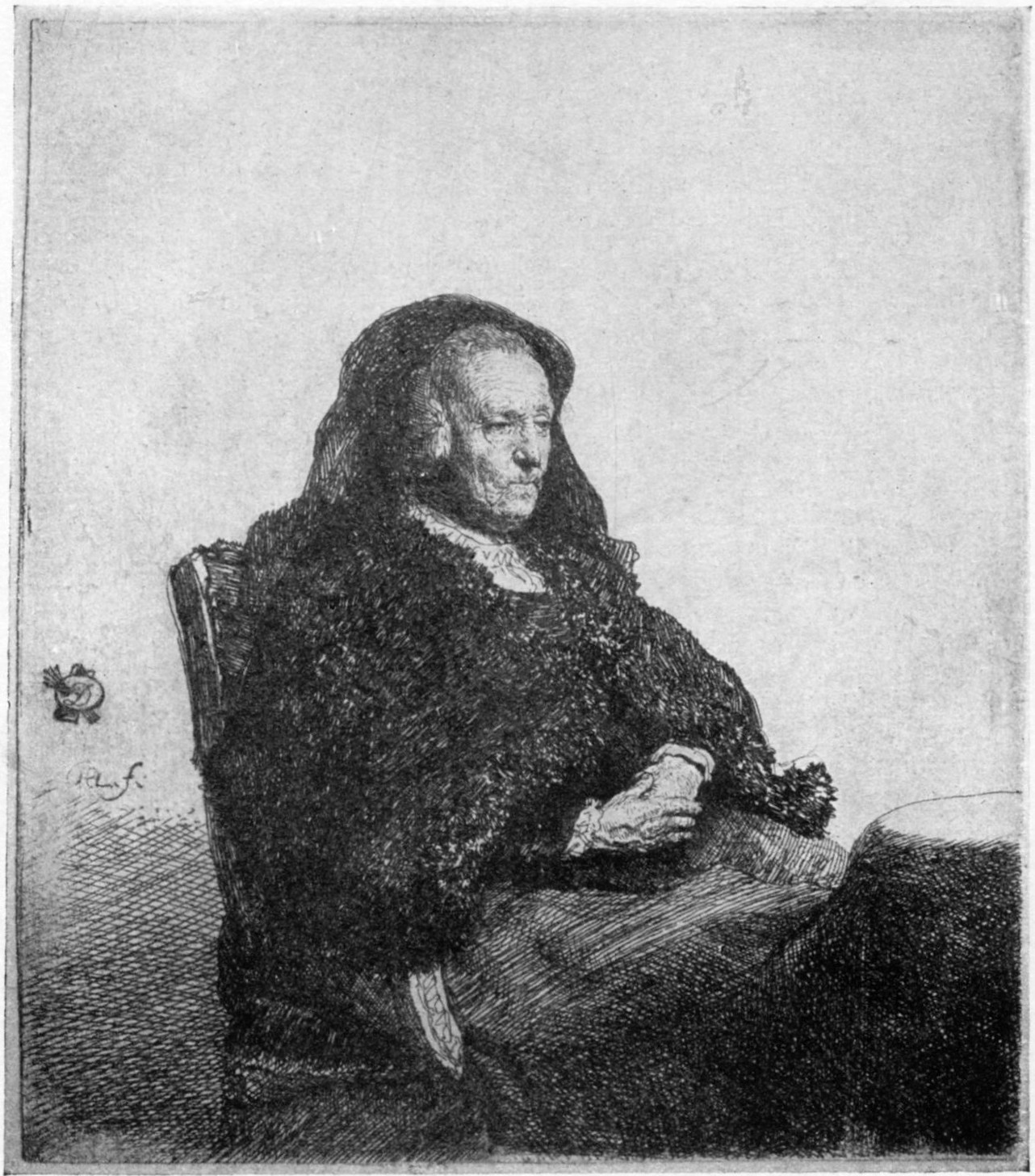
52, III. REMBRANDT'S MOTHER SEATED. (1631.) B. 343.
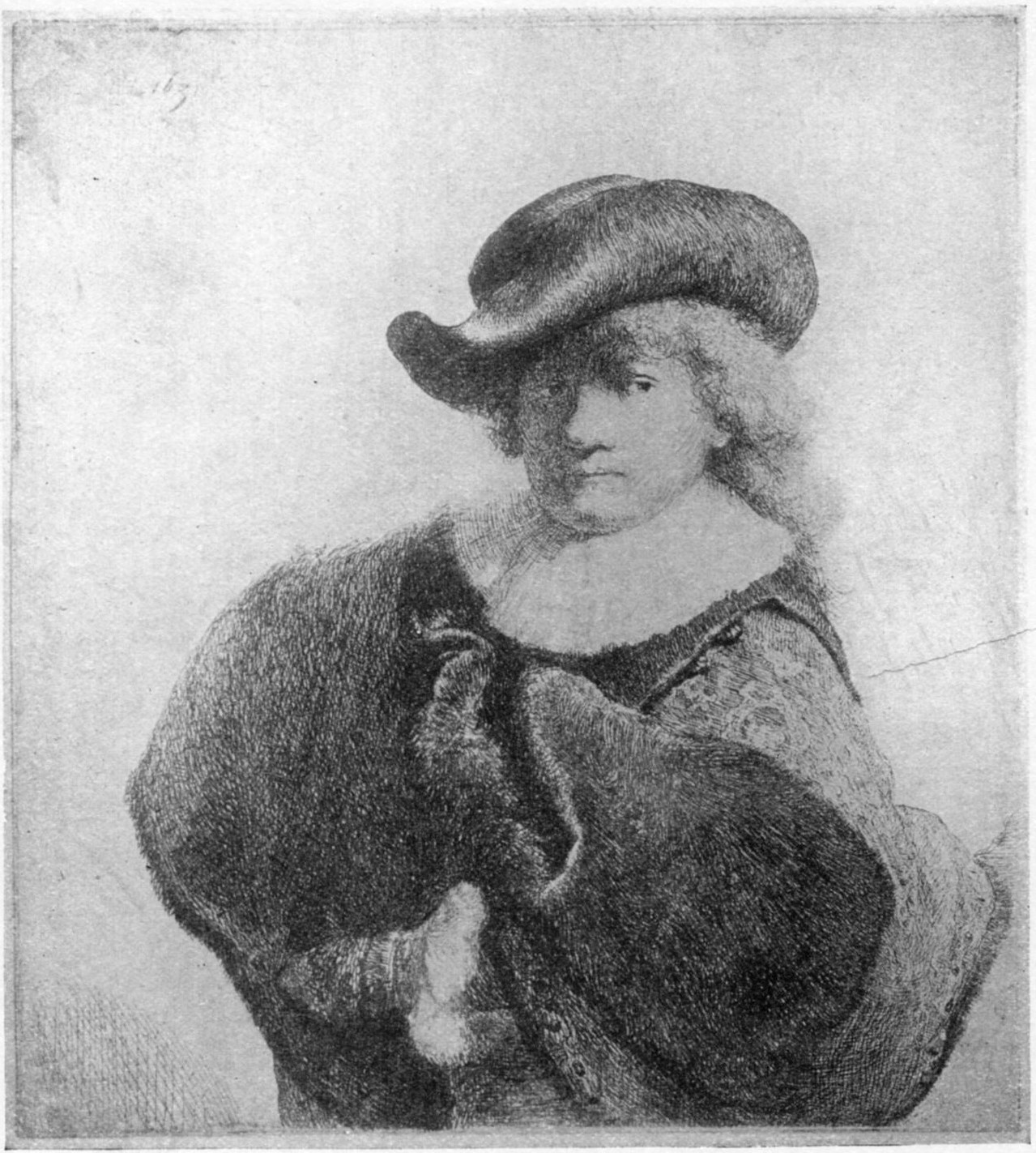
54, VI. REMBRANDT WEARING A SOFT HAT, COCKED. 1631. B. 7. Later state, the body added.
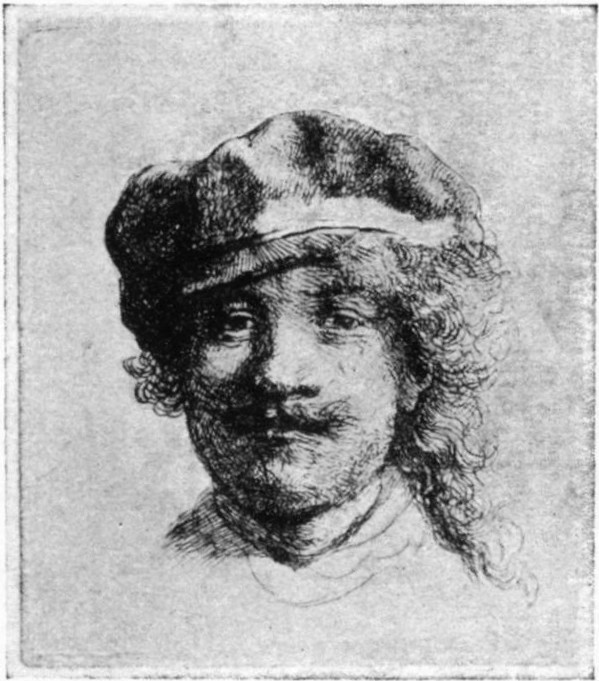
57. REMBRANDT WEARING A SOFT CAP. (1631.) B. 2
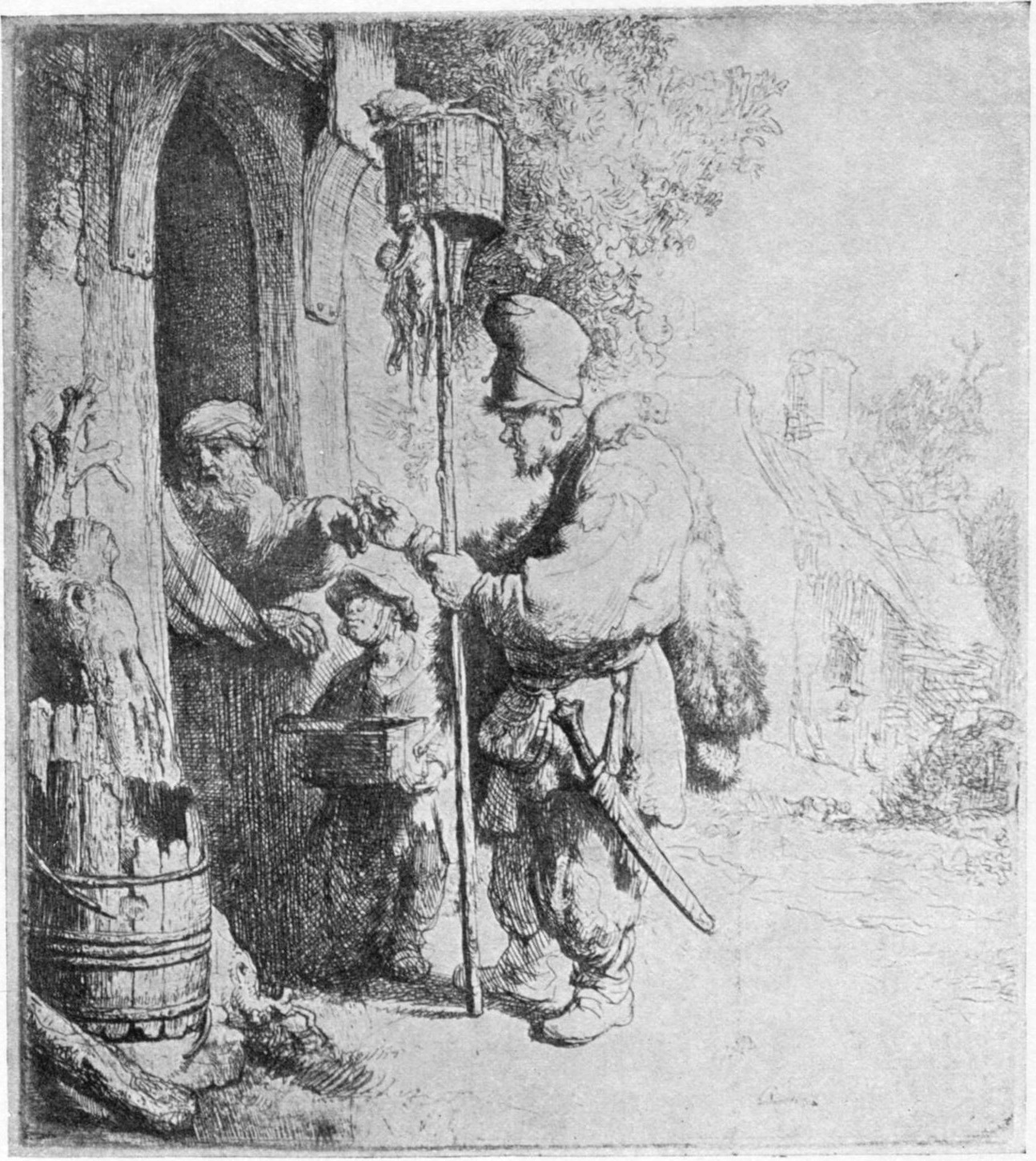
97, I. THE RAT-KILLER. 1632. B. 121
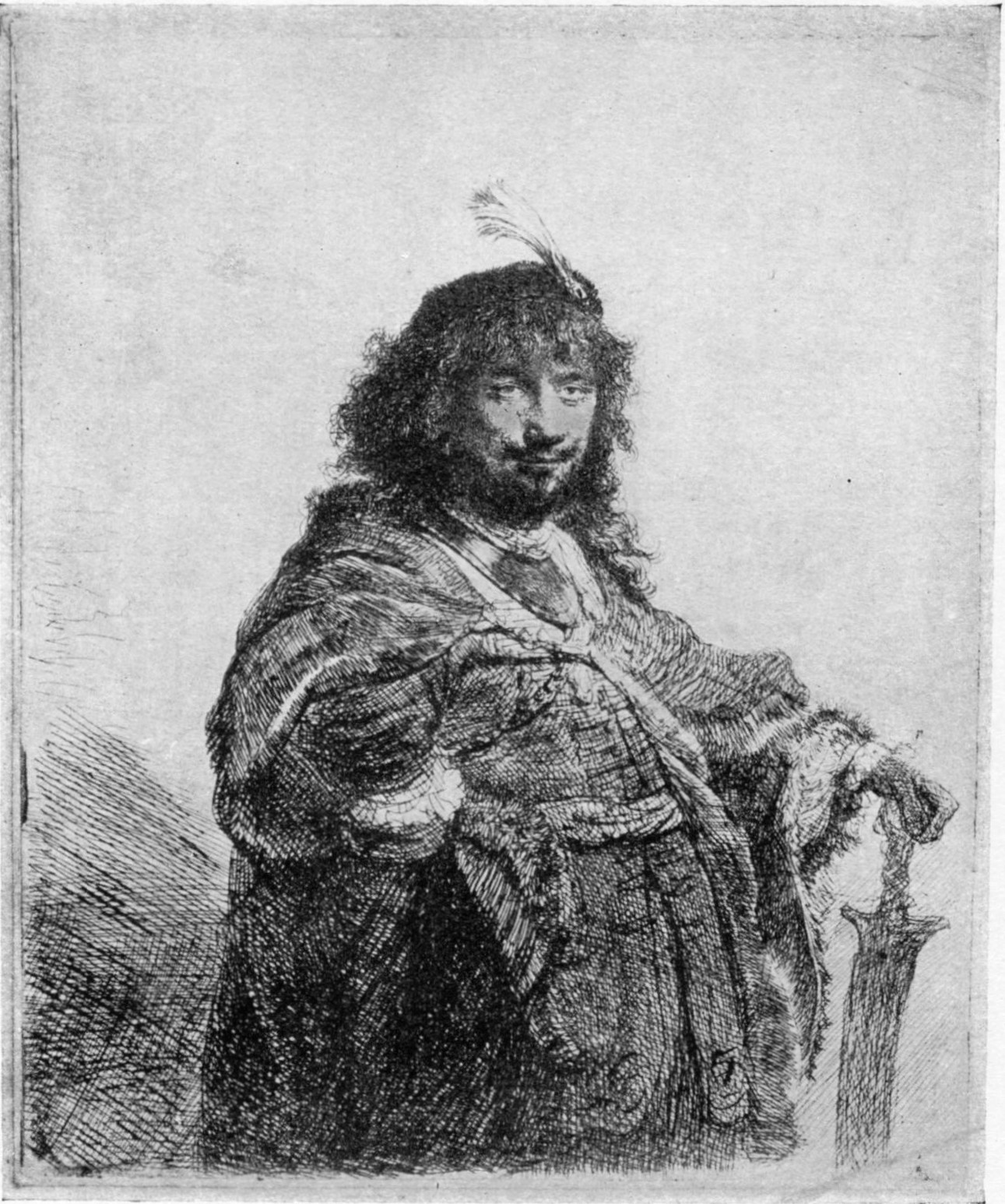
110, I. REMBRANDT WITH PLUMED HAT, AND SABRE. 1634. B. 23. This plate was afterwards cut down to a bust in an oval.
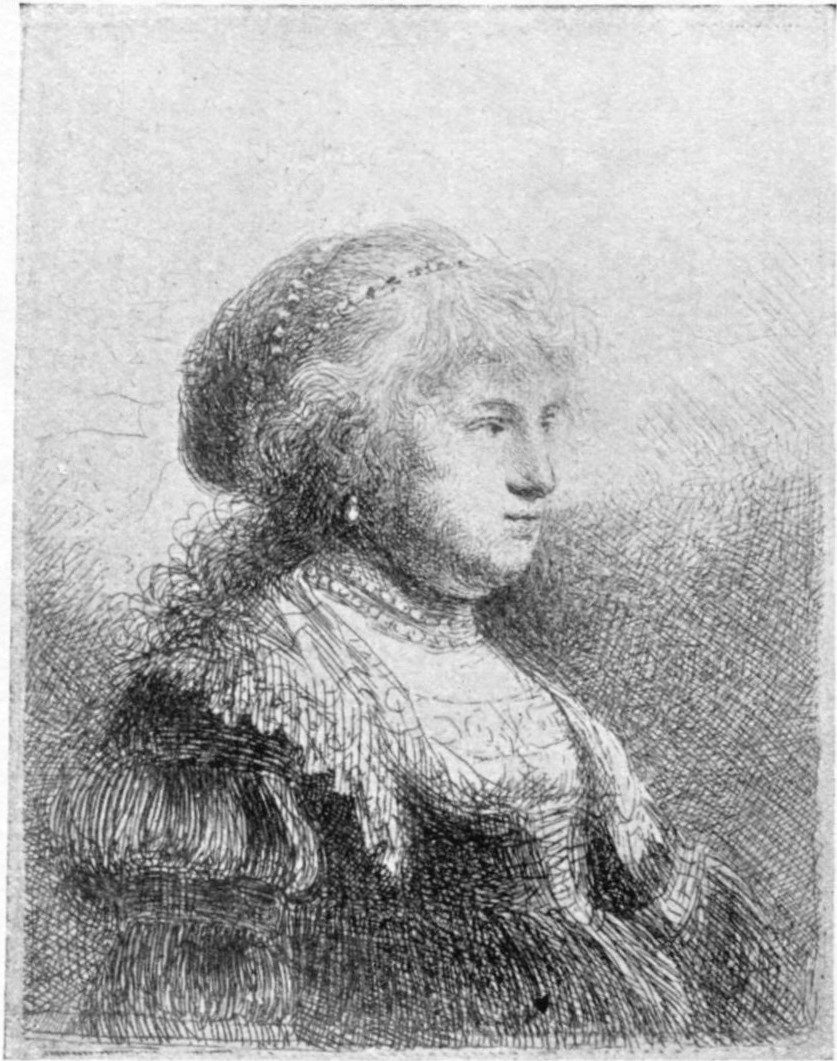
112. REMBRANDT'S WIFE, SASKIA, WITH PEARLS IN HER HAIR. 1634. B. 347
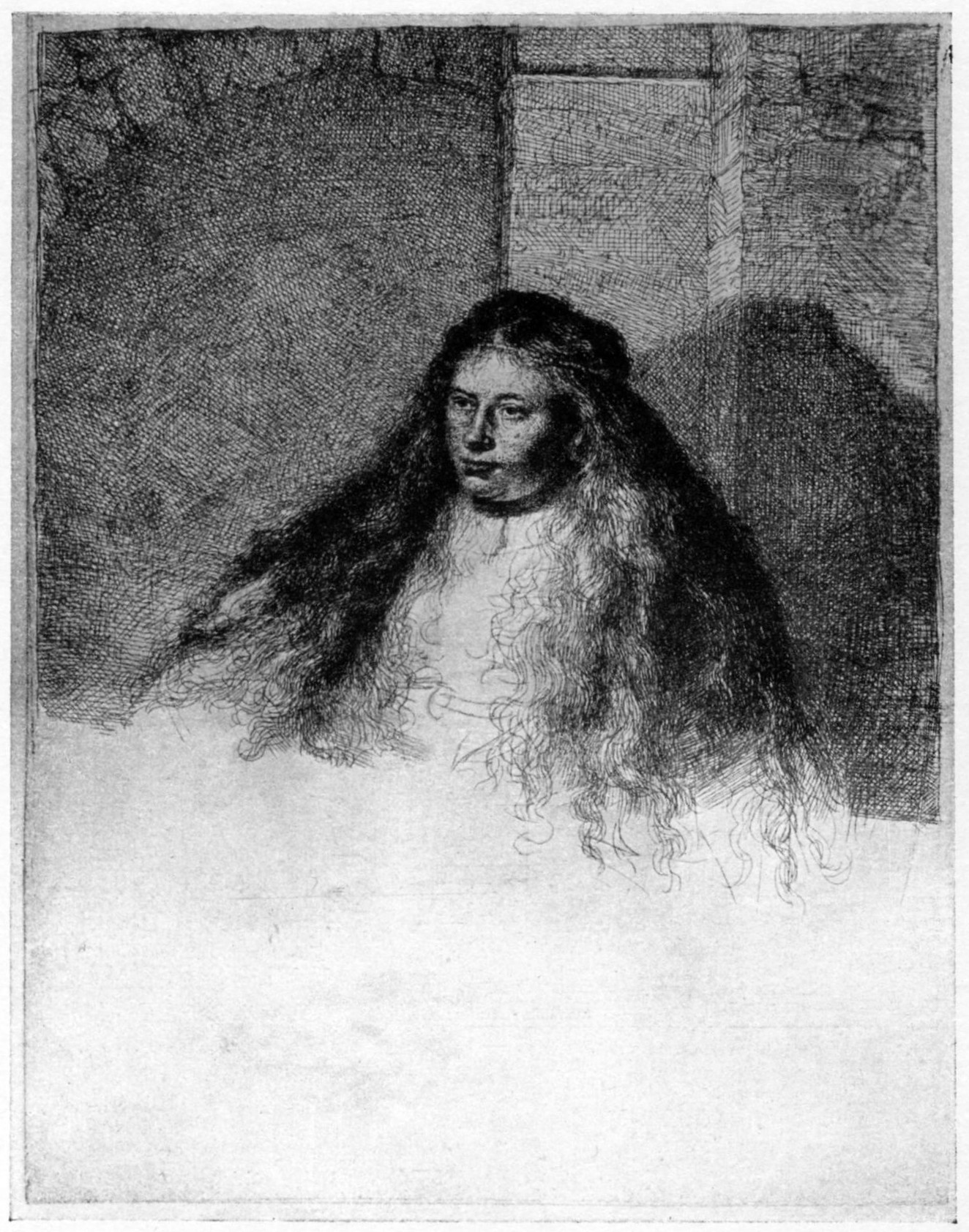
127, I. THE GREAT JEWISH BRIDE. 1635. B. 340. Unfinished state

129. OLD WOMAN SLEEPING. (1635-7.) B. 350.
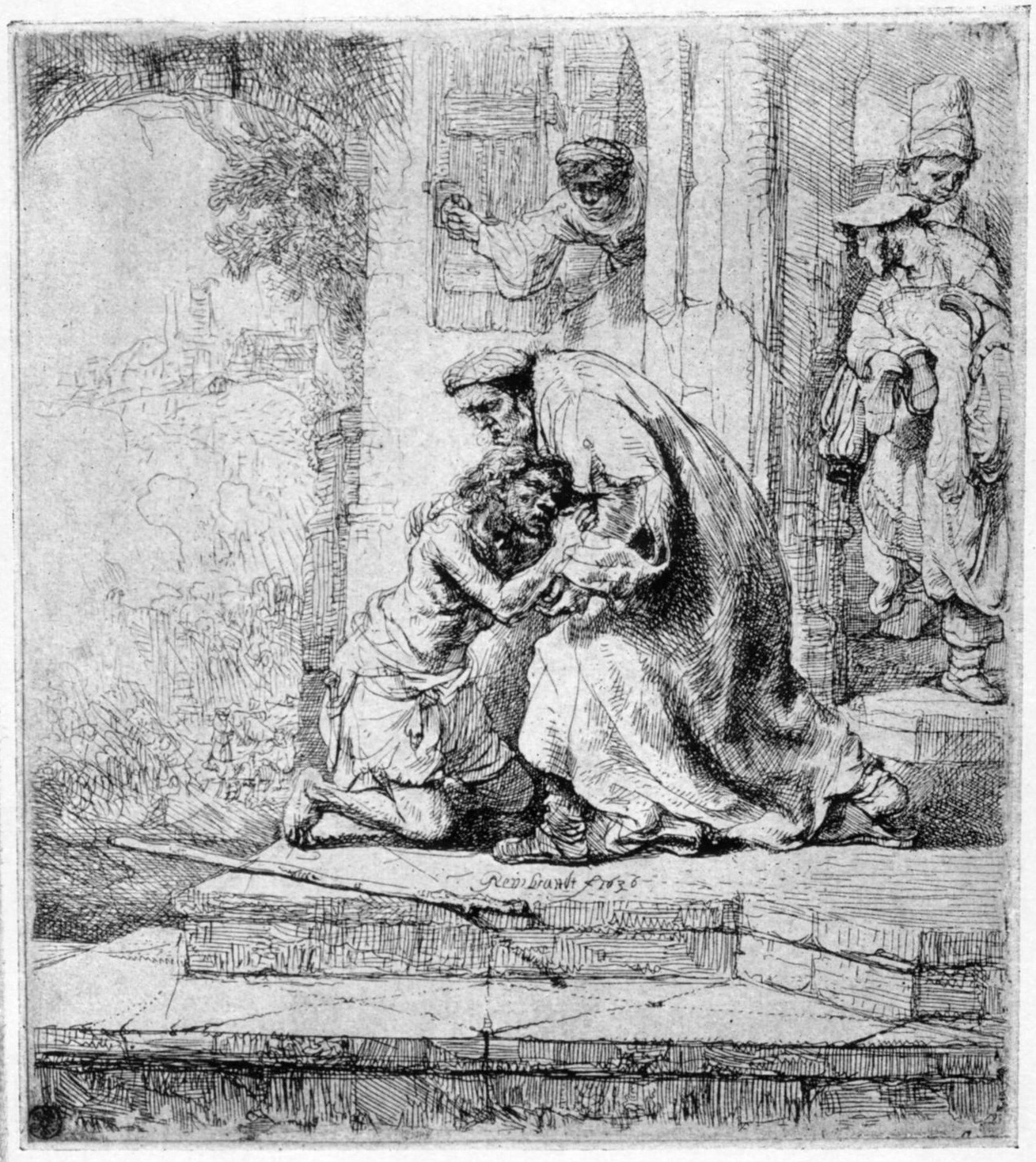
147. THE RETURN OF THE PRODIGAL SON. 1636. B. 91

151, II. YOUNG MAN IN A VELVET CAP, WITH BOOKS BESIDE HIM. 1637. B. 268

153, I. THREE HEADS OF WOMEN. (1637.) B. 367. First state, with one head (portrait of Saskia) only

161, I. THE DEATH OF THE VIRGIN. 1639. B. 99
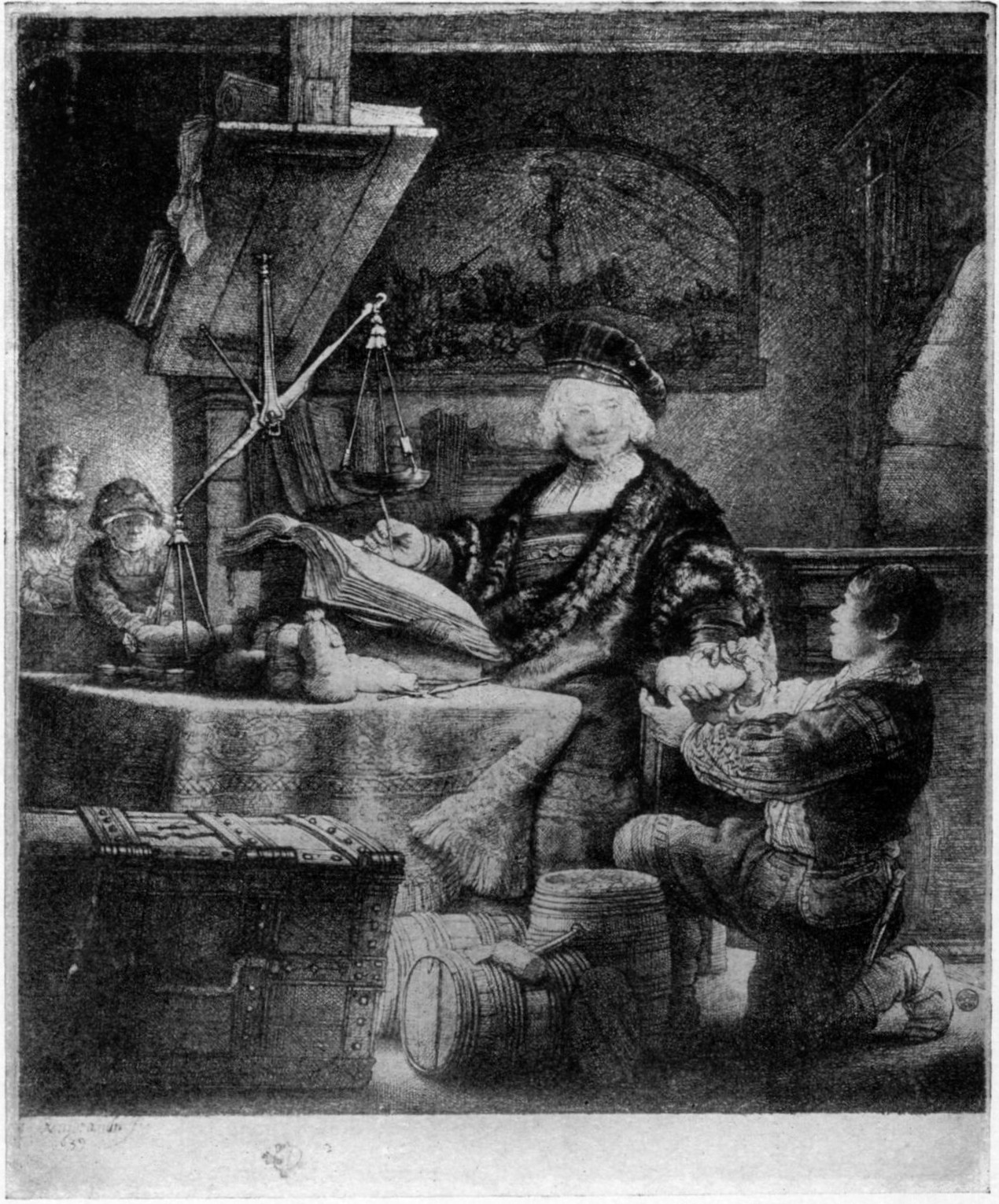
167, I. JAN UYTENBOGAERT, RECEIVER-GENERAL (THE “GOLD-WEIGHER”). 1639. B-281. First state, the face only lightly indicated
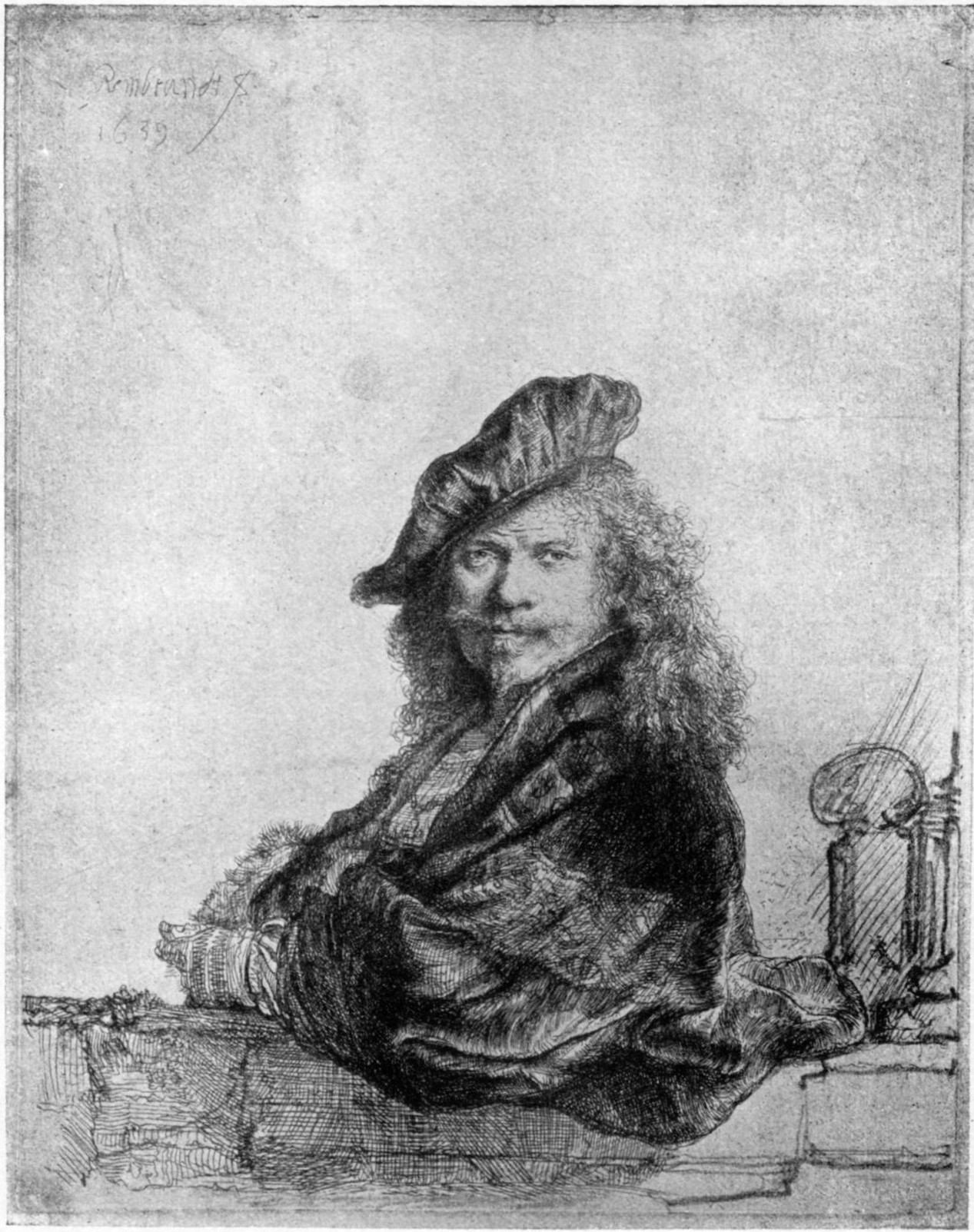
168, I. REMBRANDT LEANING ON A STONE SILL. 1639. B. 21 From an impression touched by the artist in black chalk

172. THE TRIUMPH OF MORDECAI. (1640, or later.) B. 40

175. SMALL GREY LANDSCAPE. (1640.) B. 207. 196. SICK WOMAN WITH LARGE WHITE HEAD-DRESS (SASKIA). (1642.) B. 359
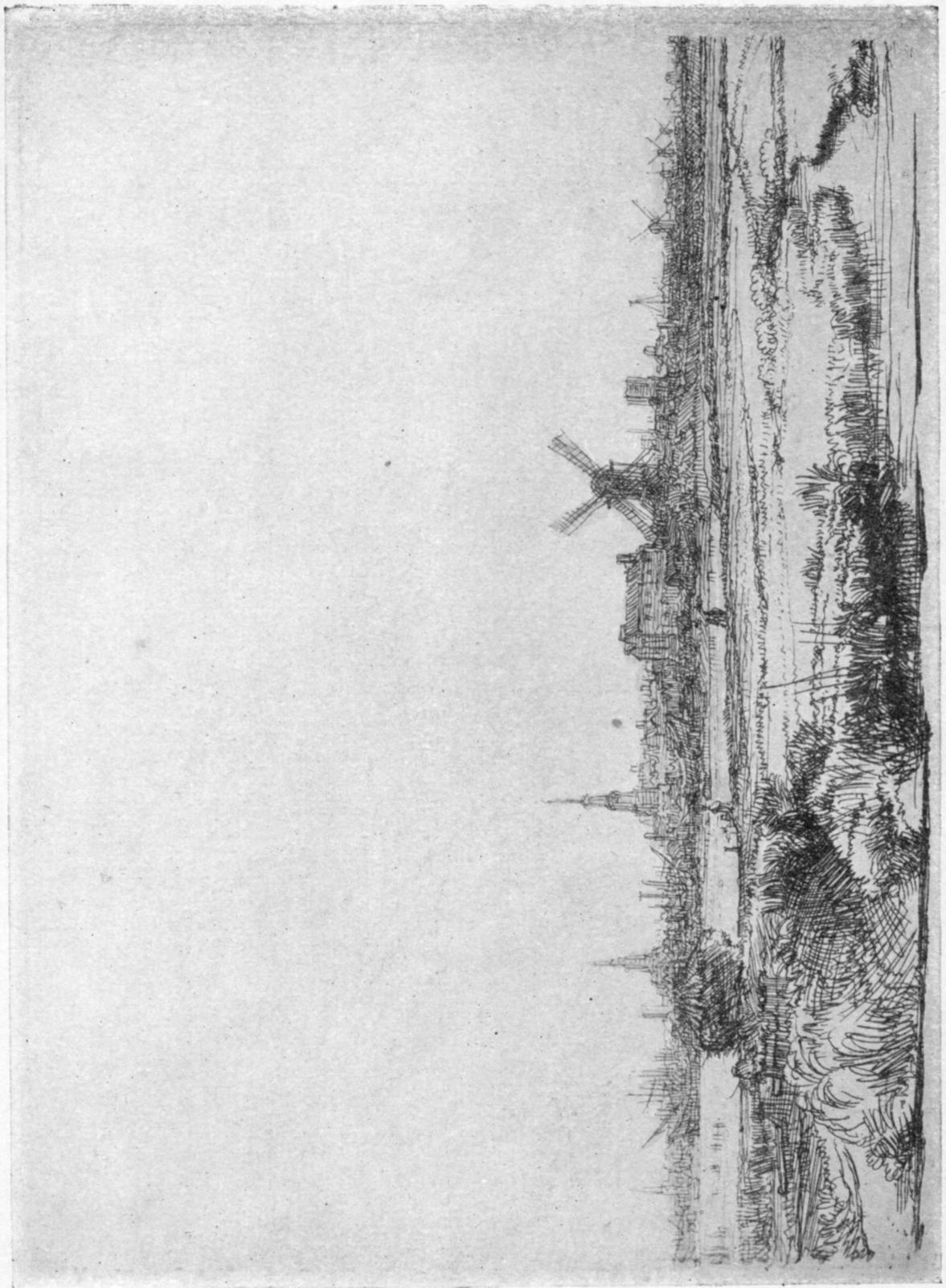
176, II. VIEW OF AMSTERDAM. (1640.) B. 210

179. THE WINDMILL. 1641. B. 233
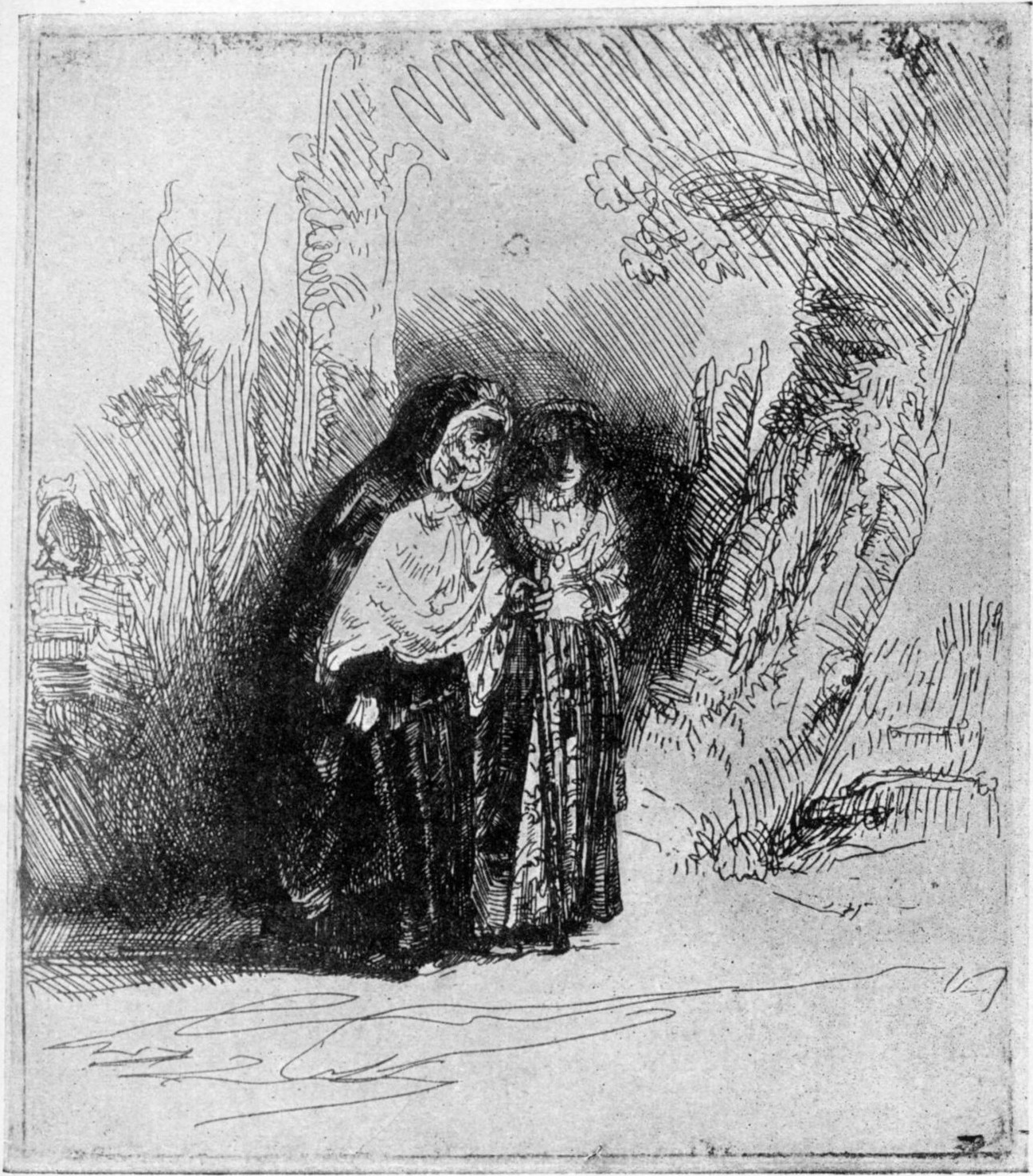
184. THE SPANISH GIPSY. (1641.) B. 120

198, I. THE RAISING OF LAZARUS. 1642. B. 72

205. THE THREE TREES. (1643.) B. 212
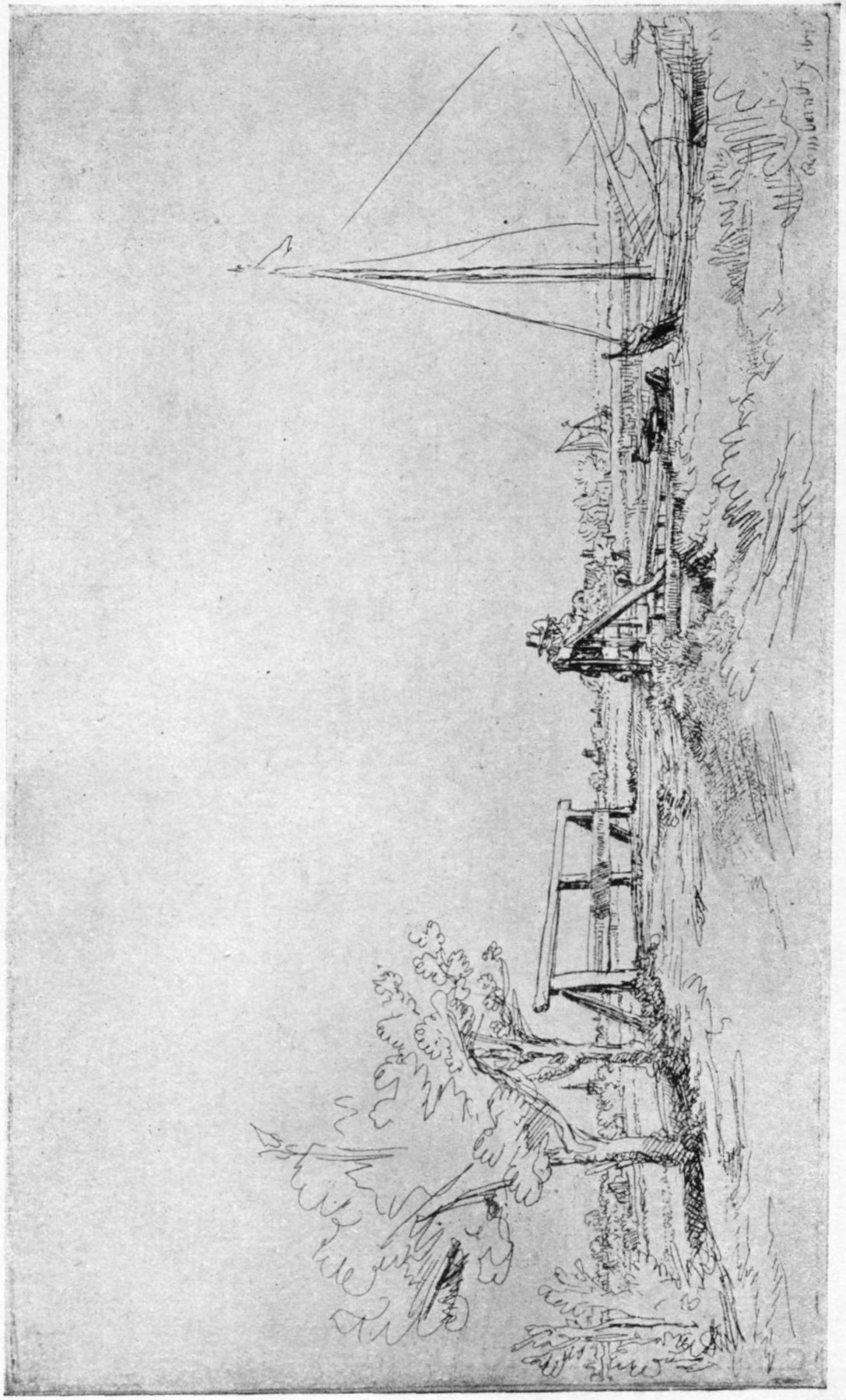
209, I. SIX'S BRIDGE. 1645. B. 208
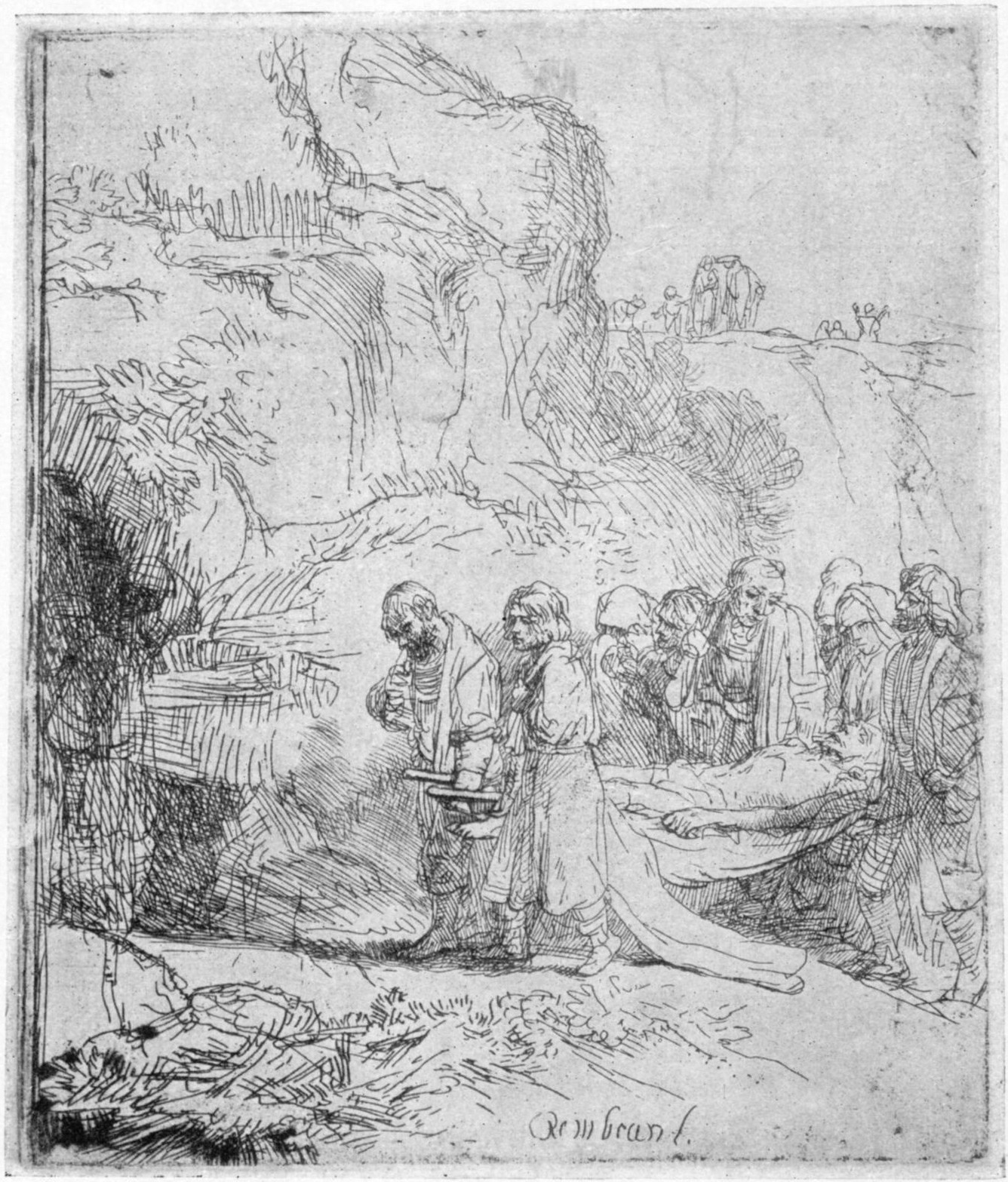
215. CHRIST CARRIED TO THE TOMB. (1645.) B. 84
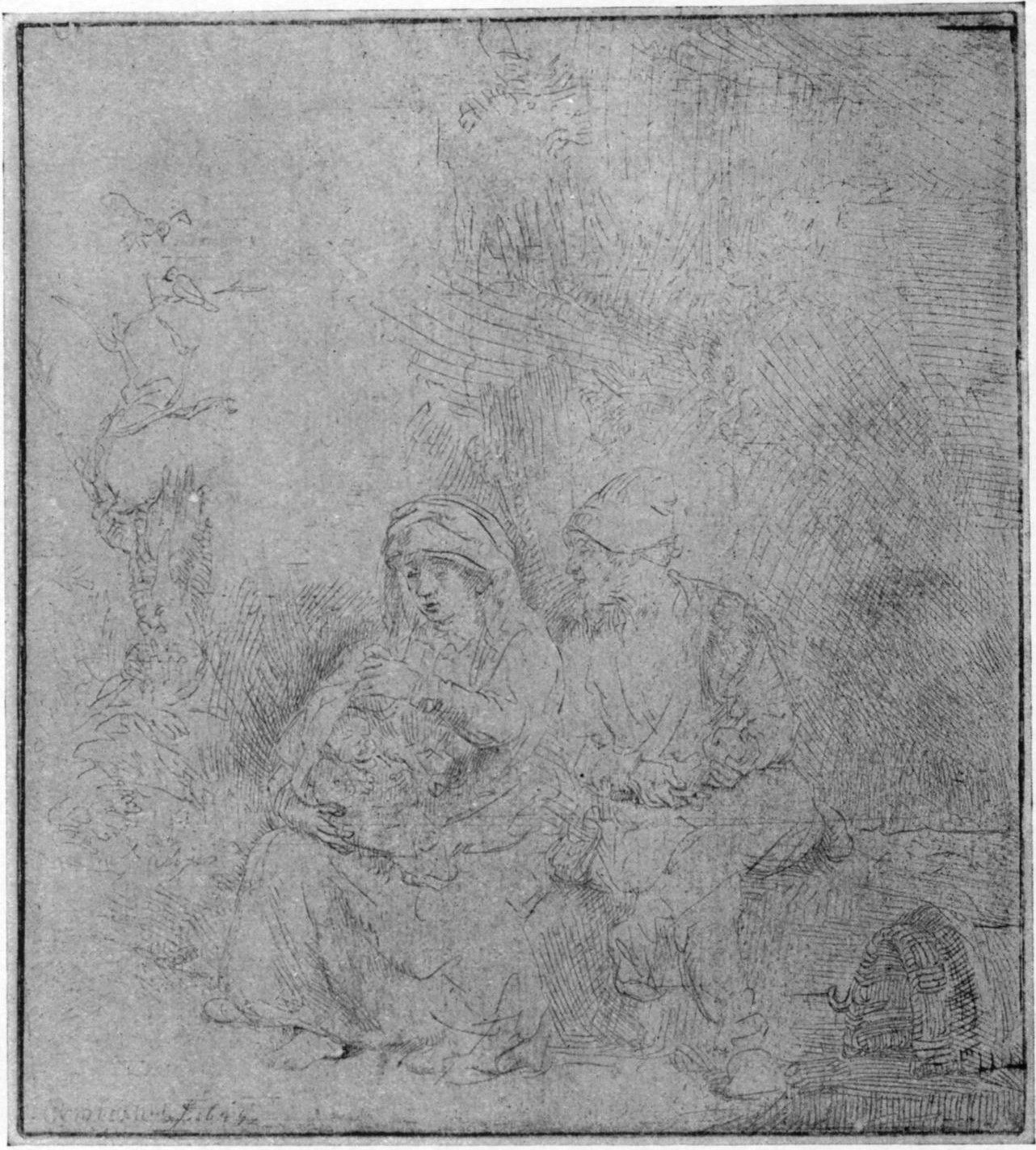
216. THE REST ON THE FLIGHT: LIGHTLY ETCHED. 1645. B. 58
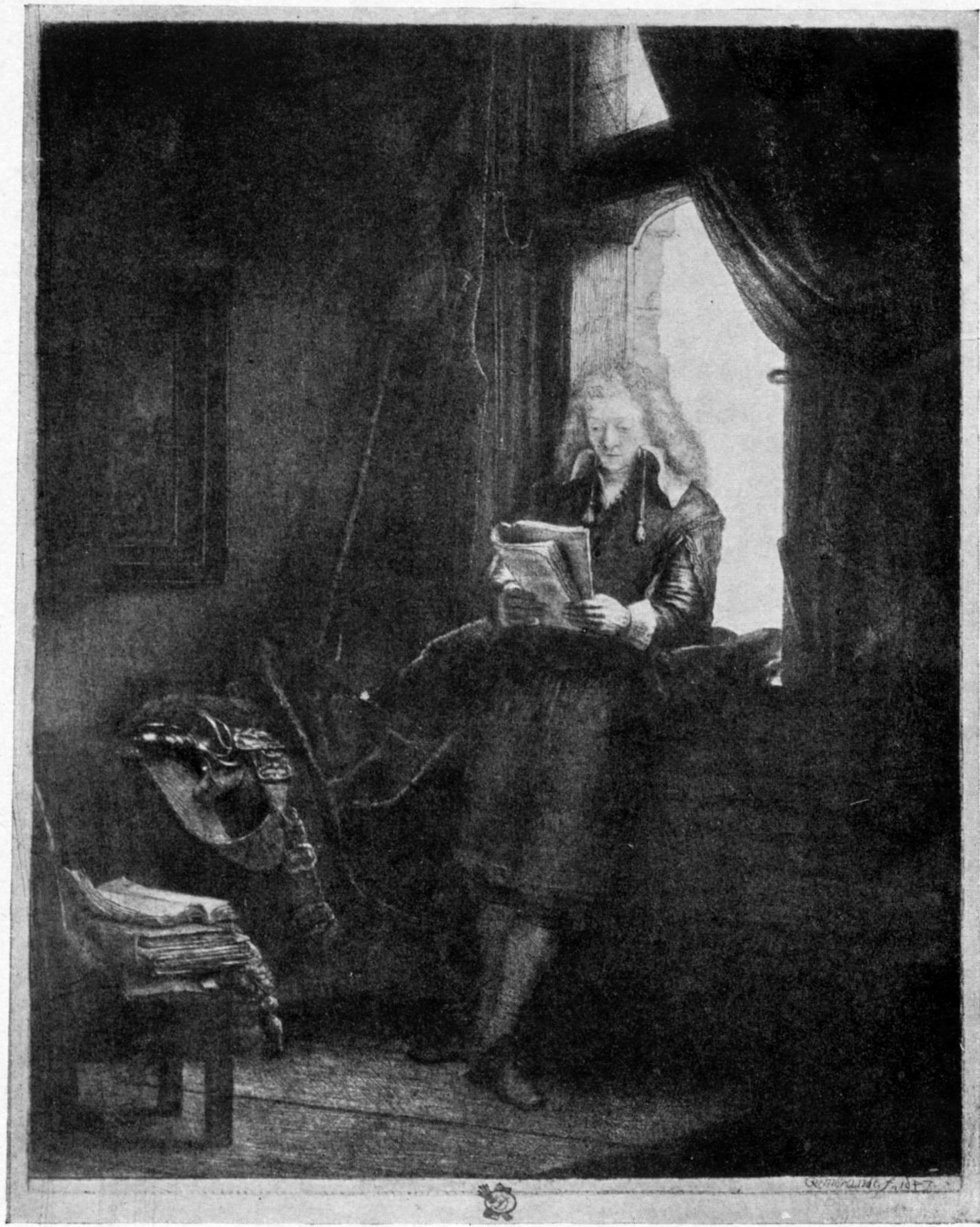
228, II. JAN SIX. 1647. B. 285
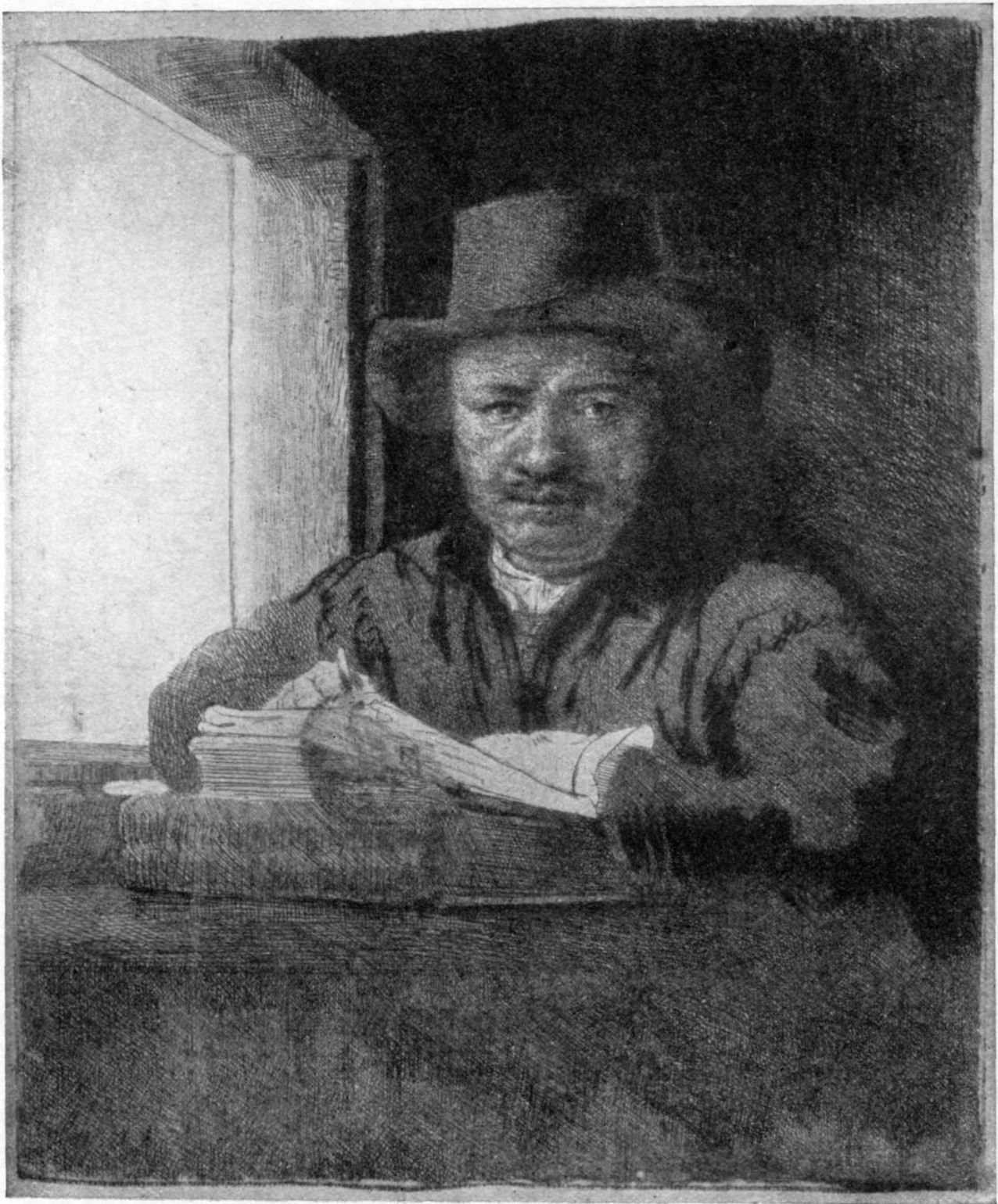
229, I. REMBRANDT DRAWING AT A WINDOW. 1648. B. 22. Unfinished state.
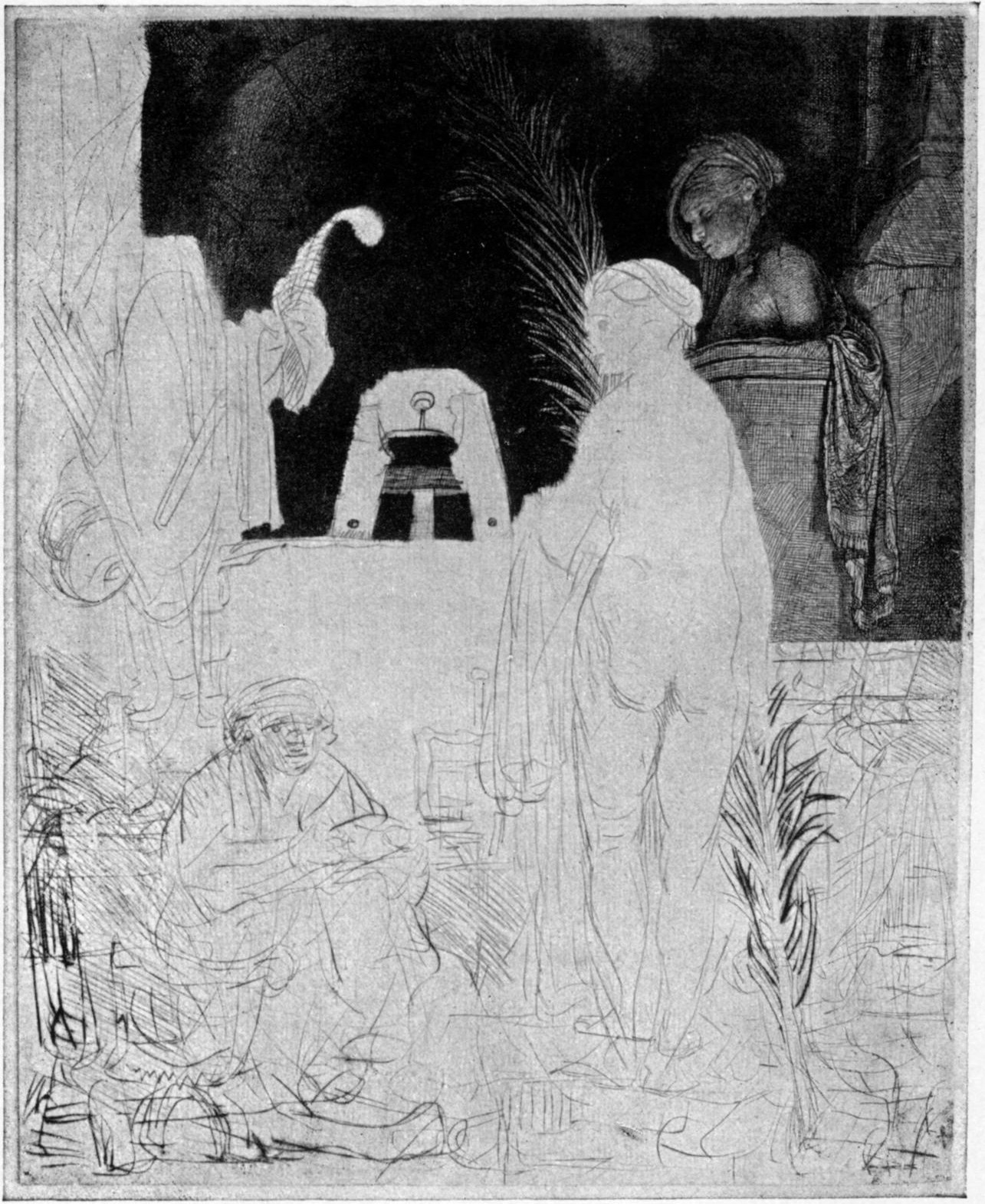
231, I. THE ARTIST DRAWING FROM A MODEL, (1648, or later?) B. 192. Unfinished plate
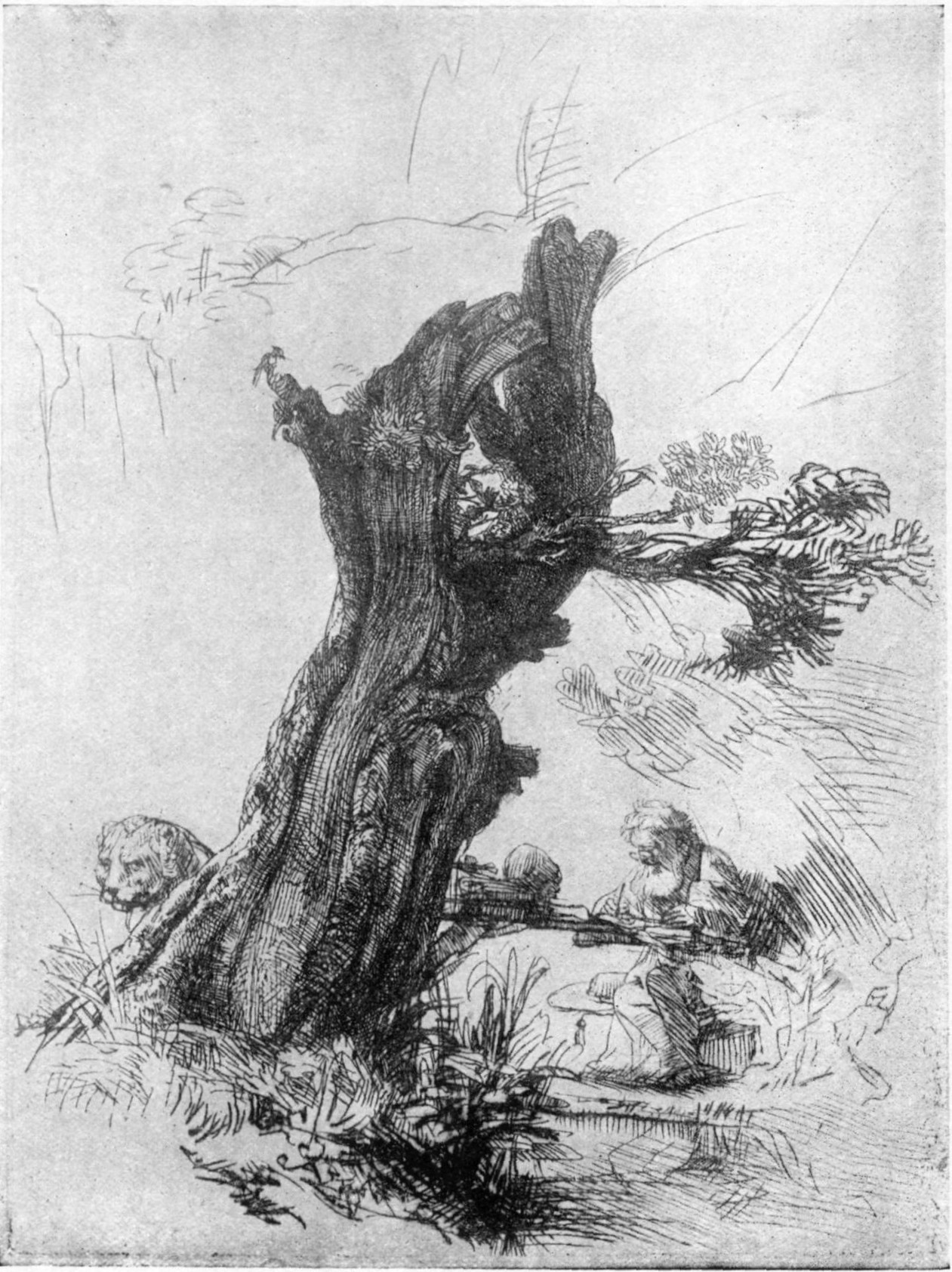
232, I. ST. JEROME BESIDE A POLLARD WILLOW. 1648. B. 103
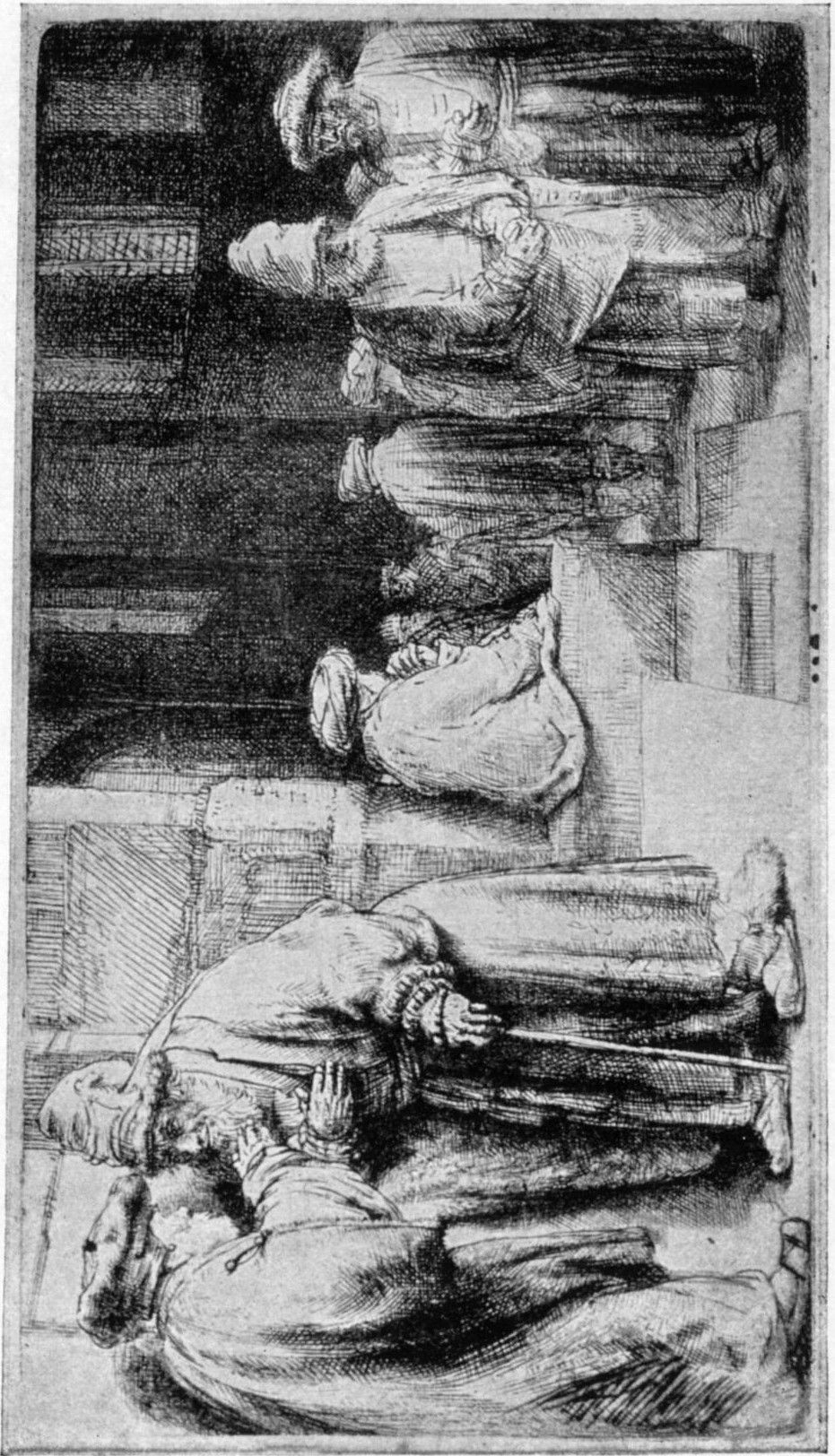
234, I. JEWS IN SYNAGOGUE. 1648. B. 126

236, I. CHRIST, WITH THE SICK AROUND HIM, RECEIVING LITTLE CHILDREN (The “Hundred Guilder Print”). (1649.) B. 74. First state, before adding shading on the neck of the ass, r. Only nine impressions of this state are known, two being in the British Museum
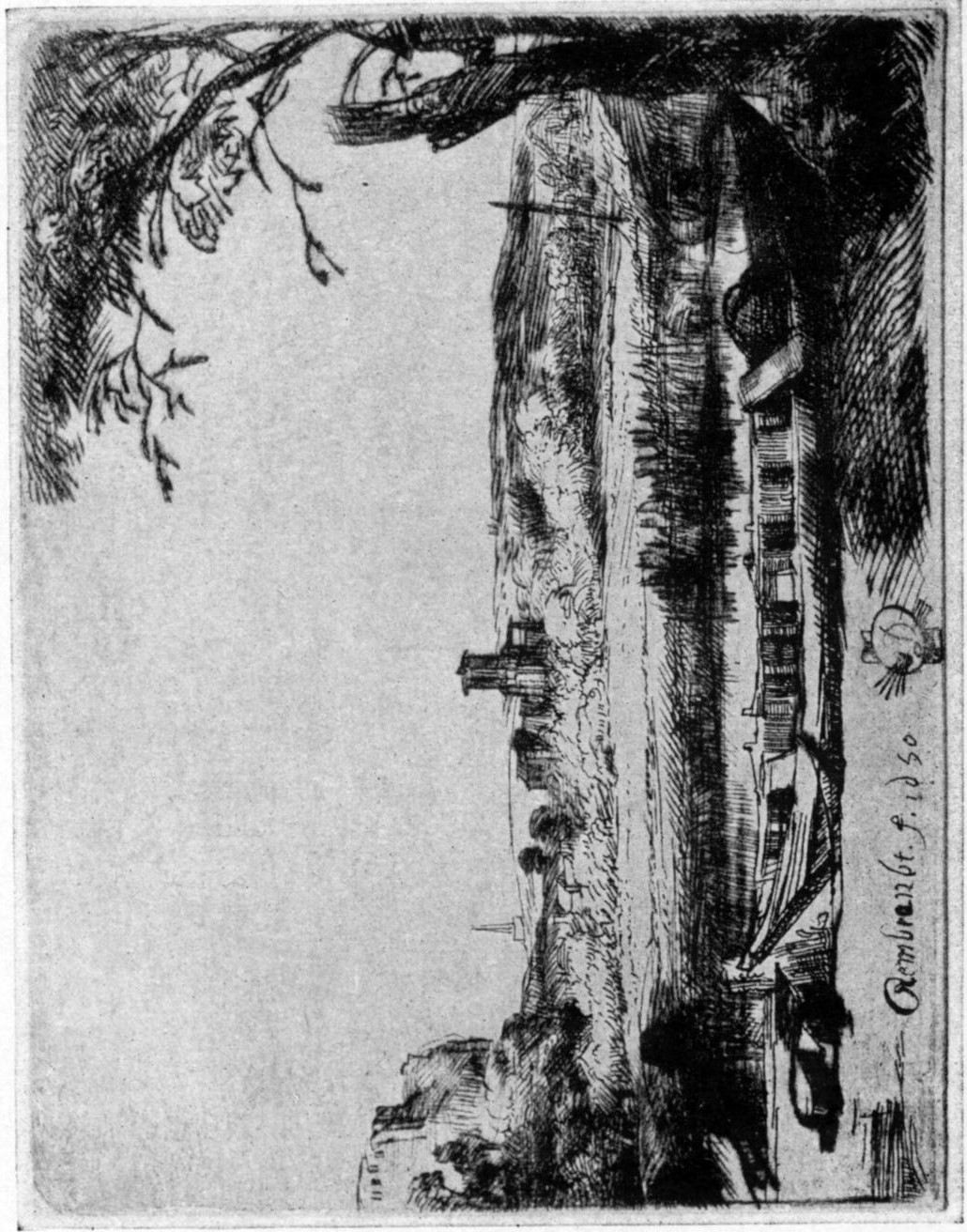
239, I. CANAL WITH A LARGE BOAT AND BRIDGE. 1650. B. 236
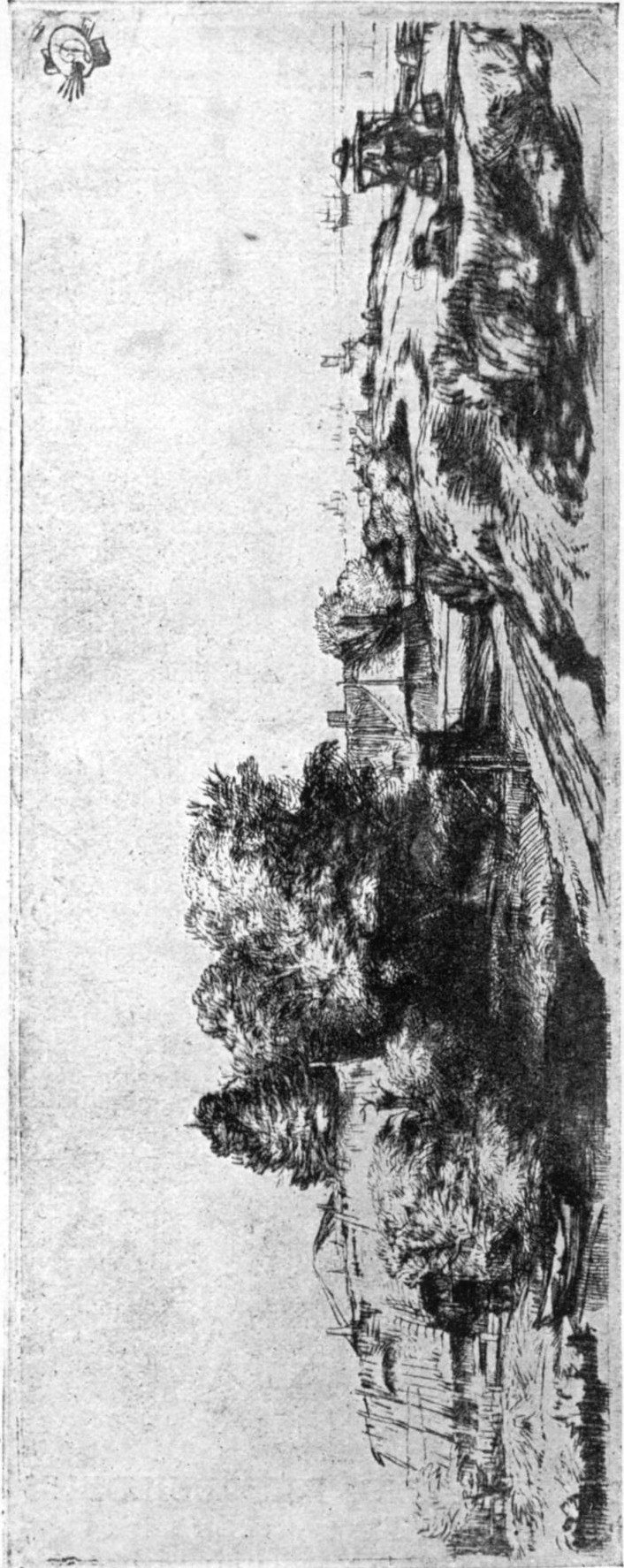
242, I. LANDSCAPE WITH A MILKMAN. (1650.) B. 213
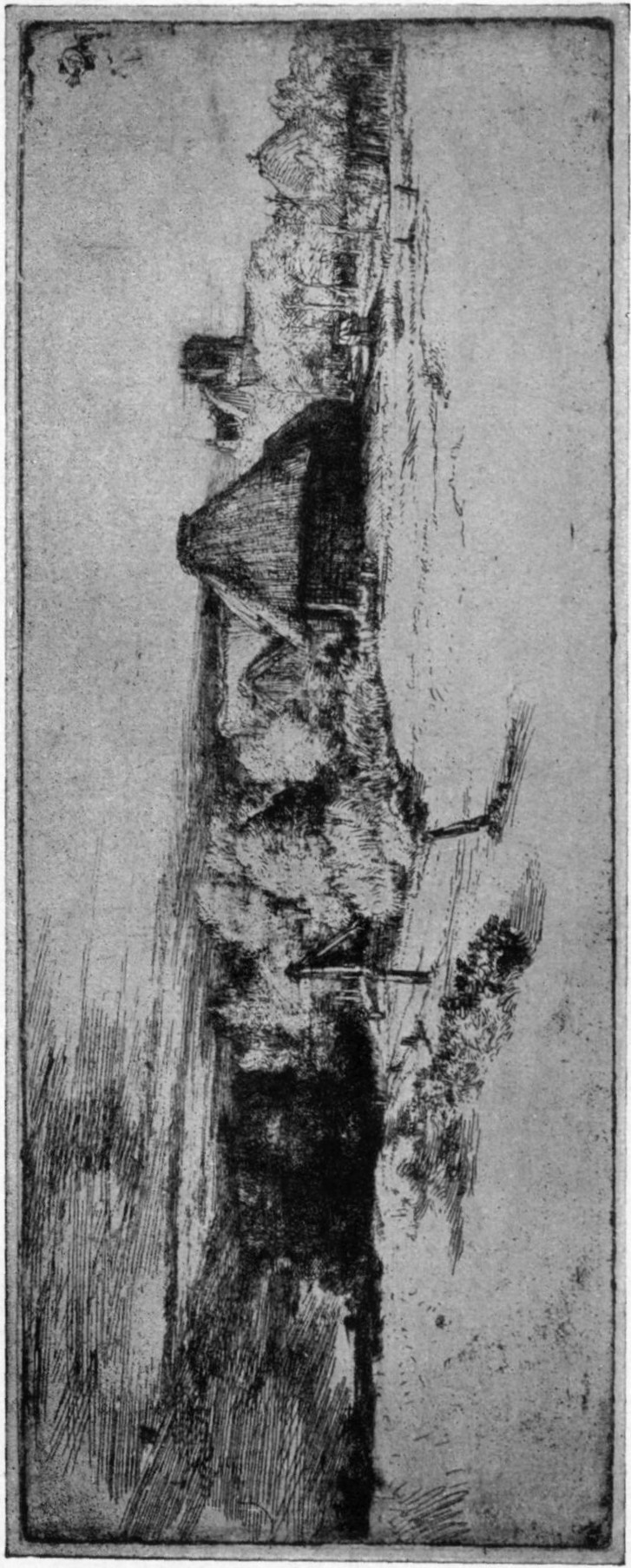
244, III. LANDSCAPE WITH TREES, FARM BUILDINGS AND A TOWER. (1650.) B. 223. The two earlier states show the tower surmounted by a. cupola, which was burnished out to increase the concentration of the subject
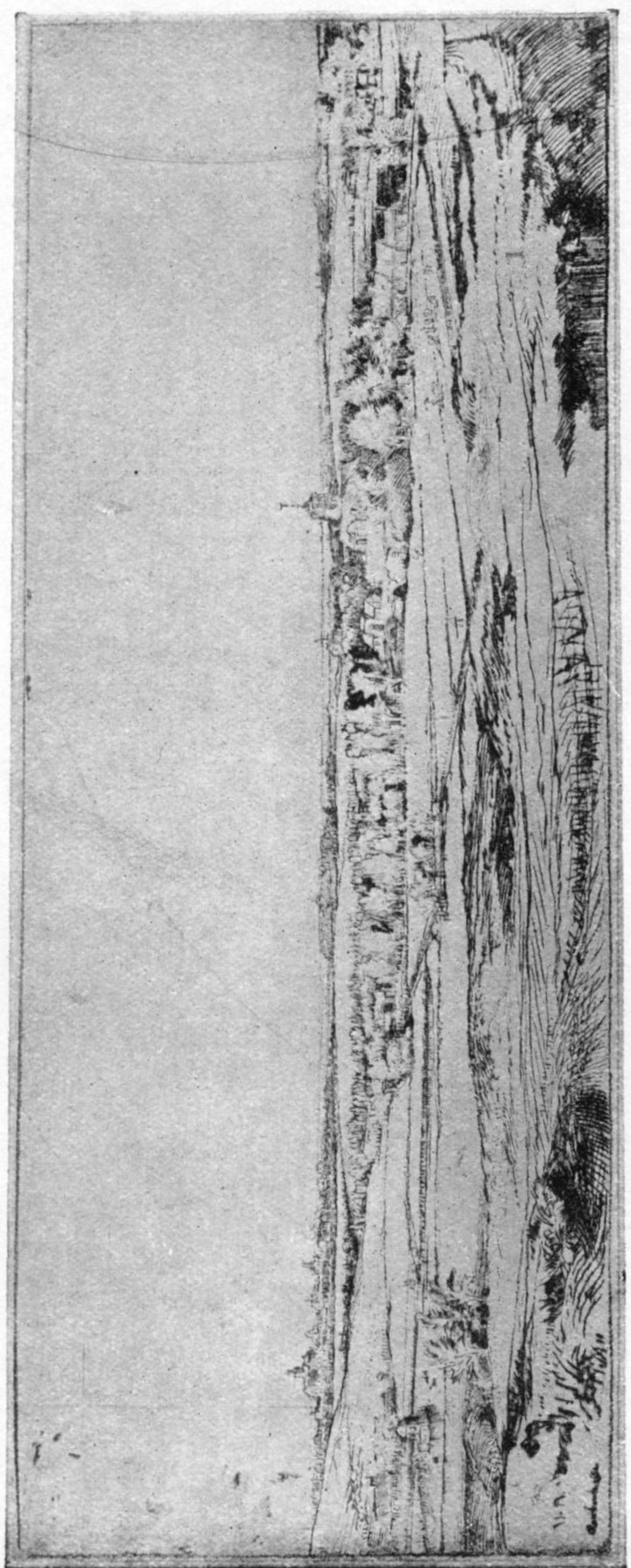
249. THE GOLDWEIGHER'S FIELD. 1651. B. 234
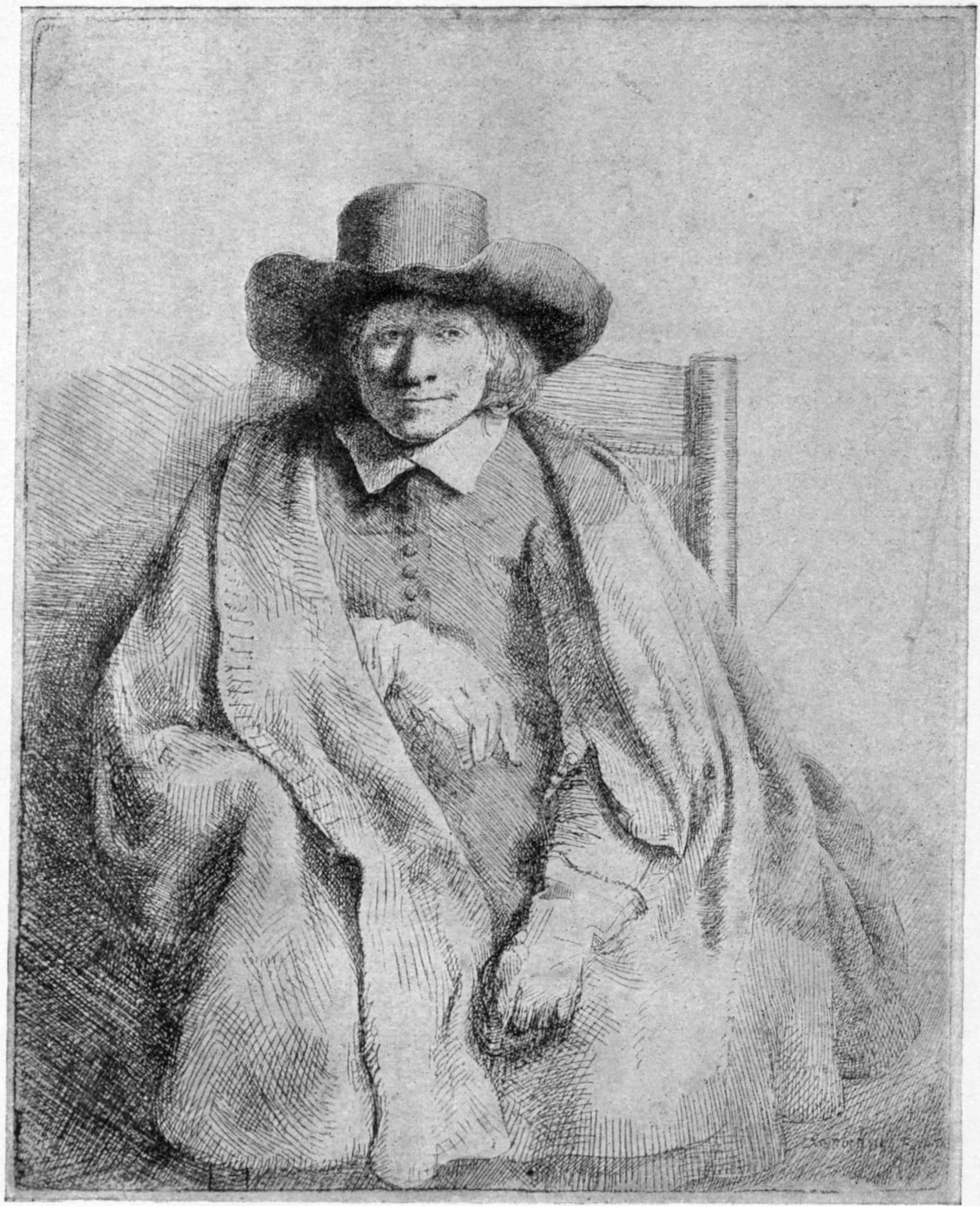
251, I. CLEMENT DE JONGHE, PRINTSELLER. 1651. B. 272
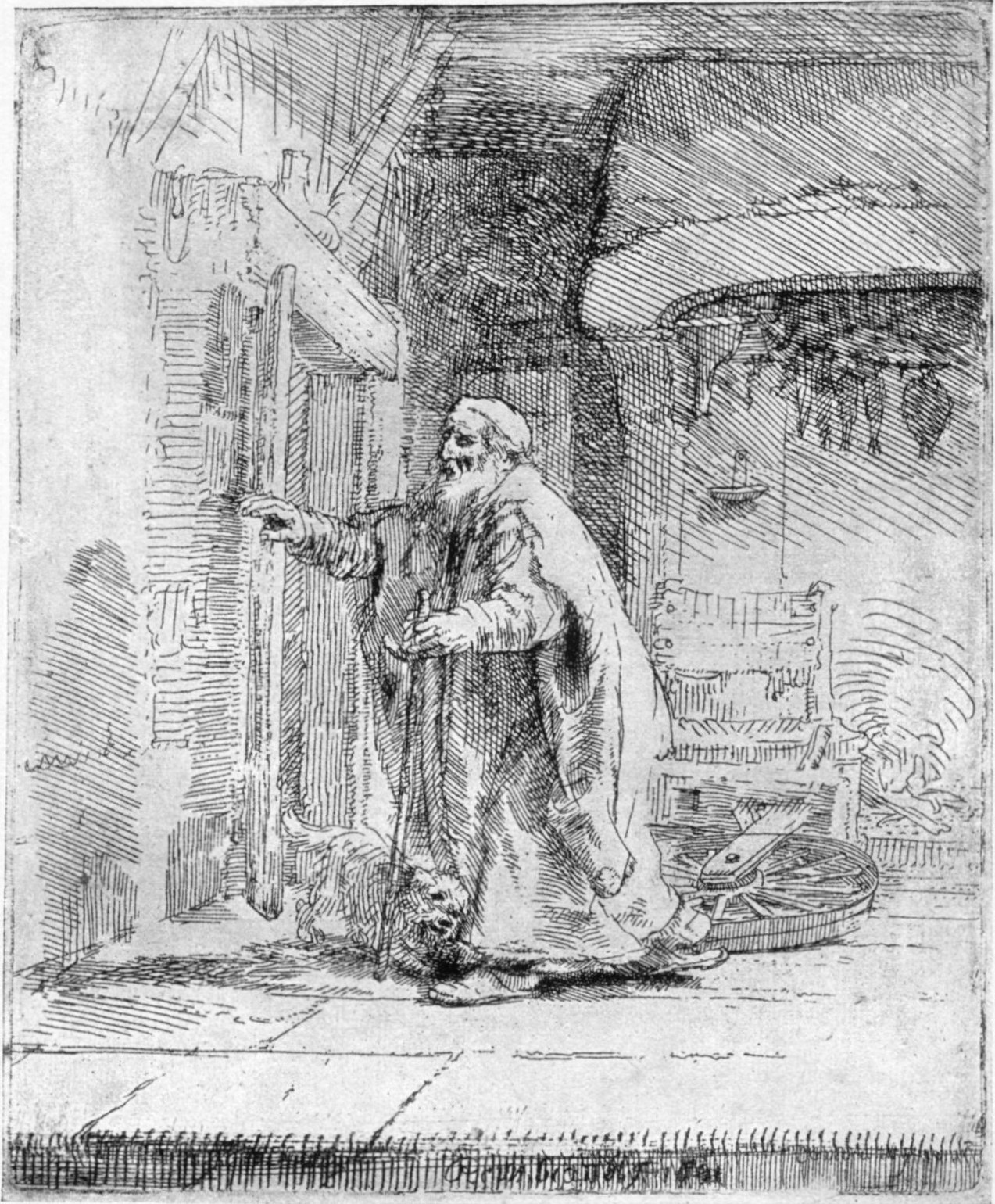
252. THE BLINDNESS OF TOBIT: THE LARGER PLATE. 1651. B. 42
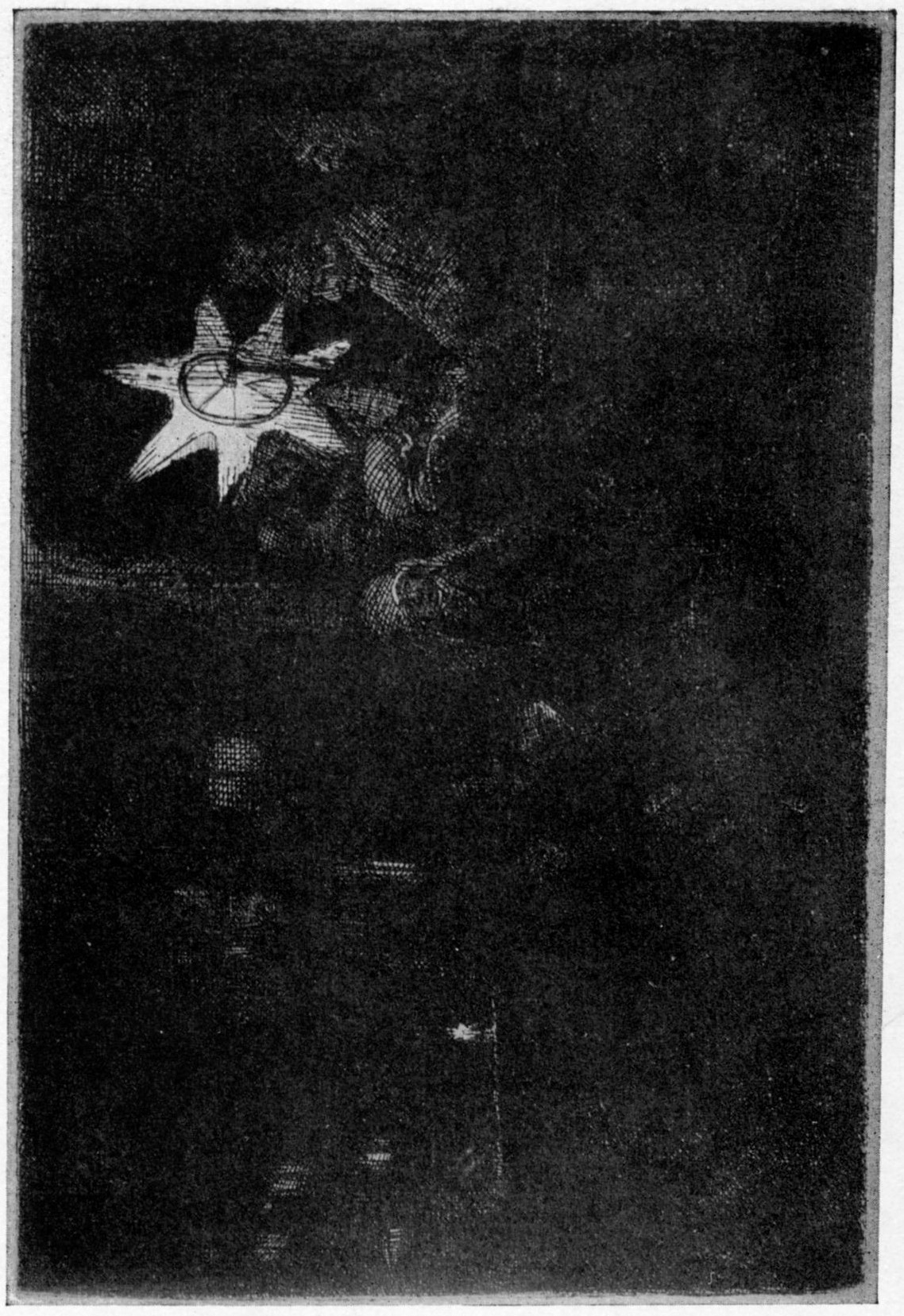
254. THE STAR OF THE KINGS: A NIGHT PIECE. (1652.) B. 113
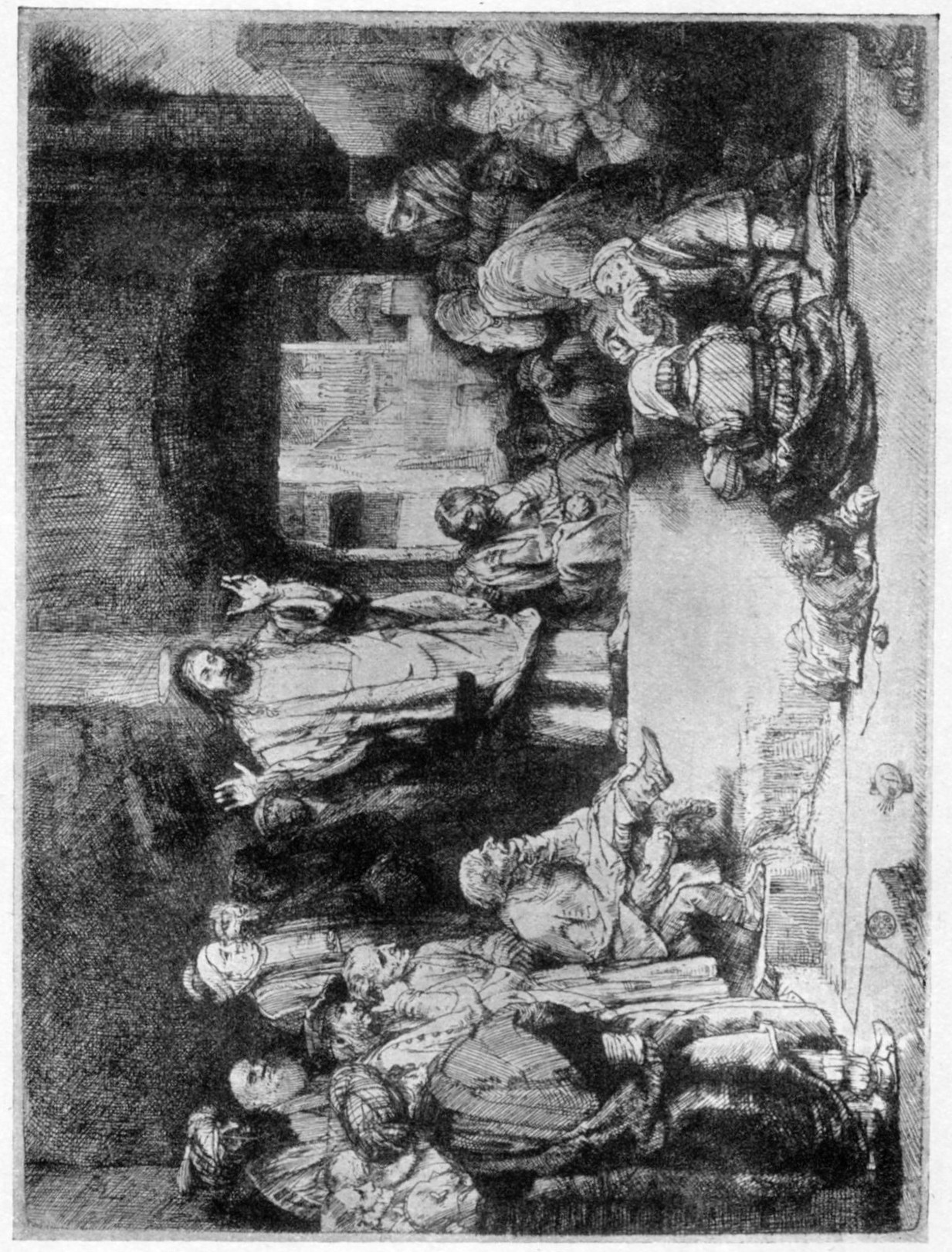
256. CHRIST PREACHING (“LA PETITE TOMBE”). 1652 B. 67
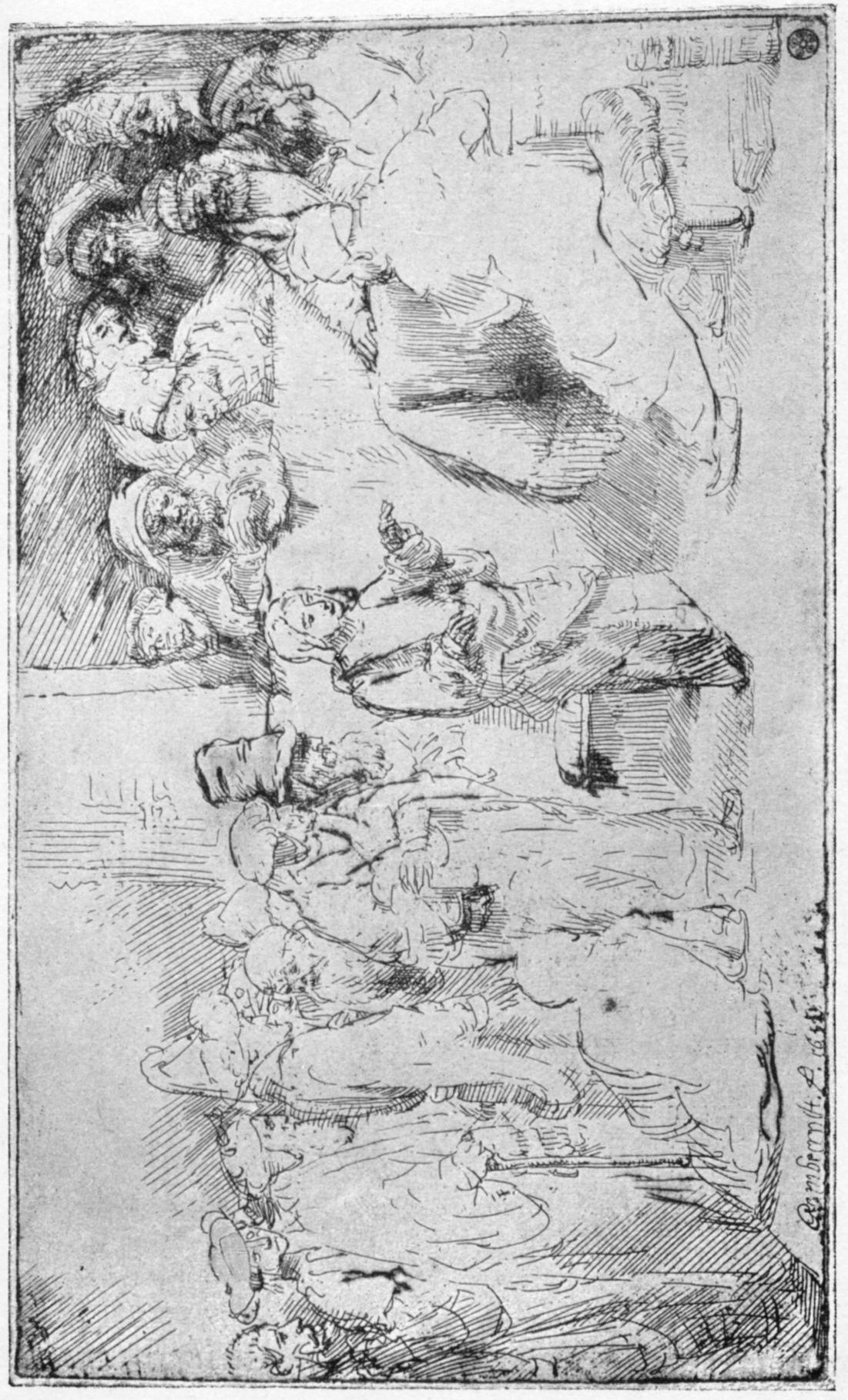
257, I. CHRIST DISPUTING WITH THE DOCTORS; A SKETCH. 1652. B. 65
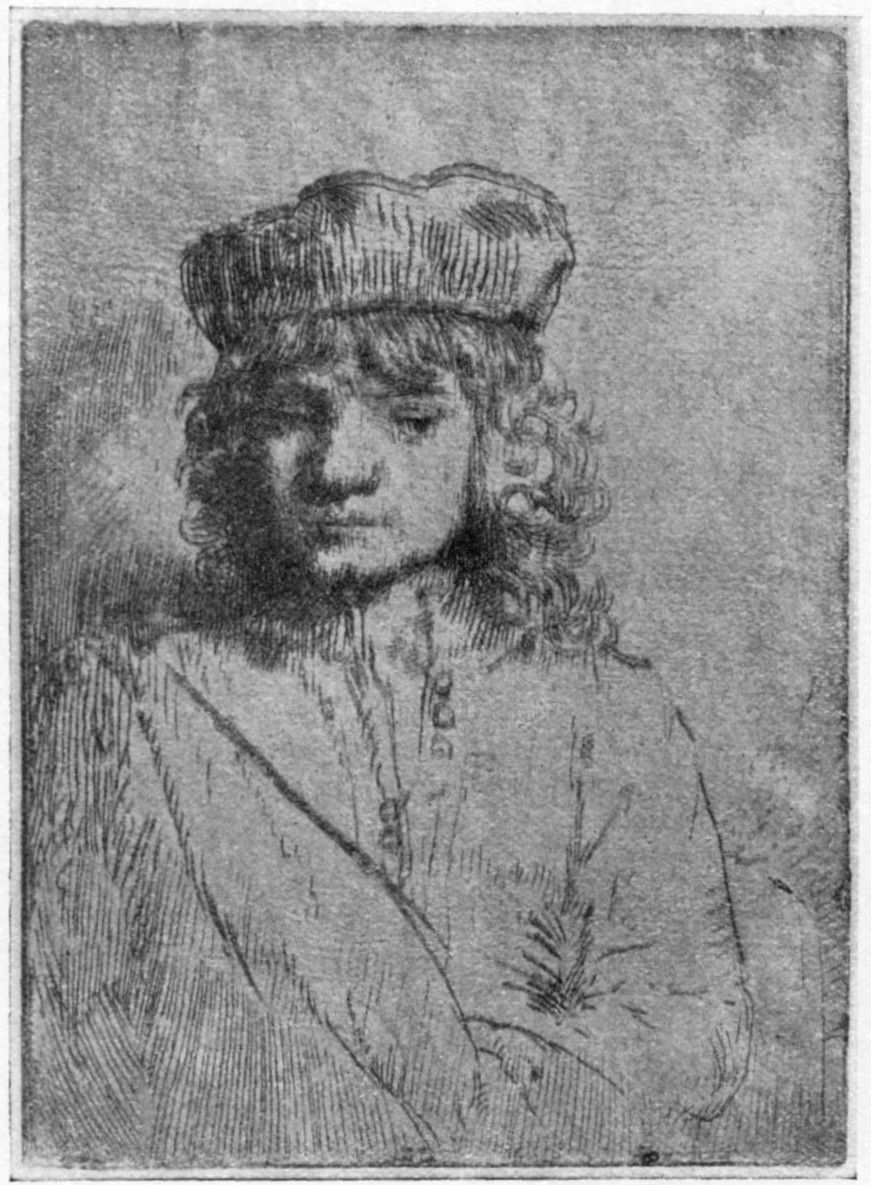
261. TITUS VAN RYN, REMBRANDT'S SON. (1656.) B. 11
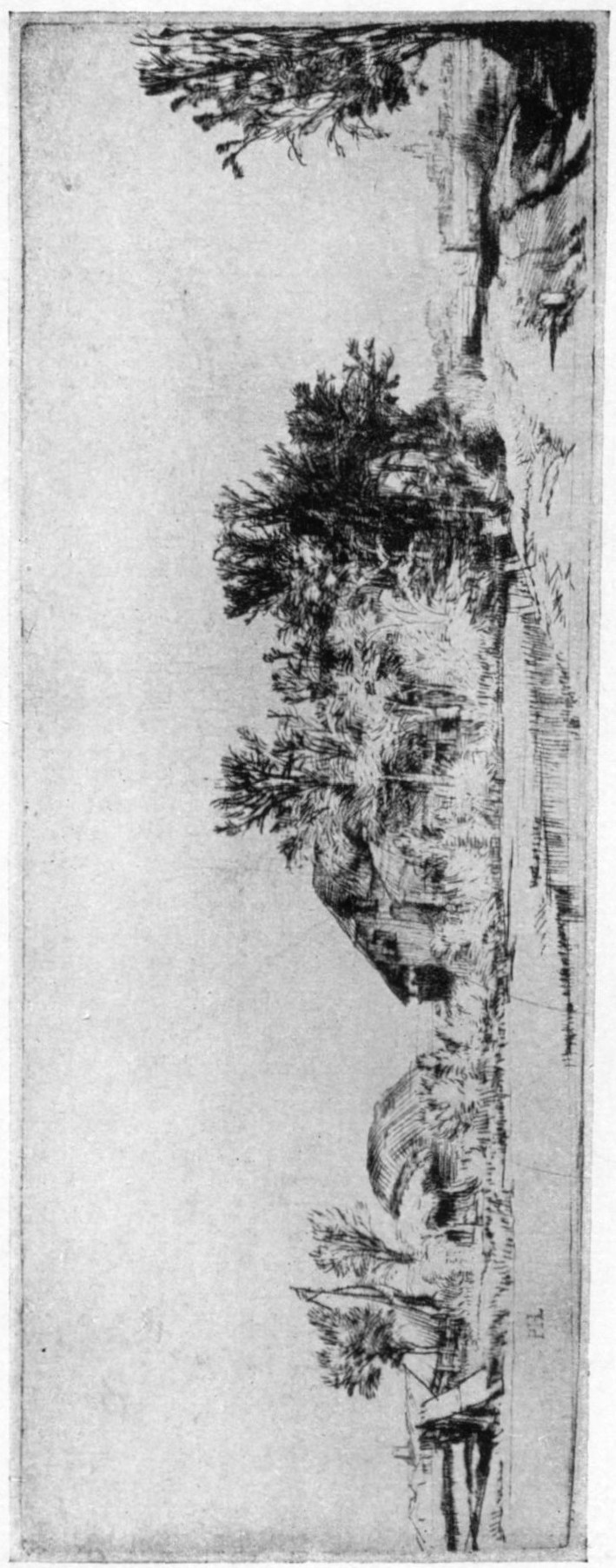
264. LANDSCAPE WITH A ROAD BESIDE A CANAL. 1652. B. 221
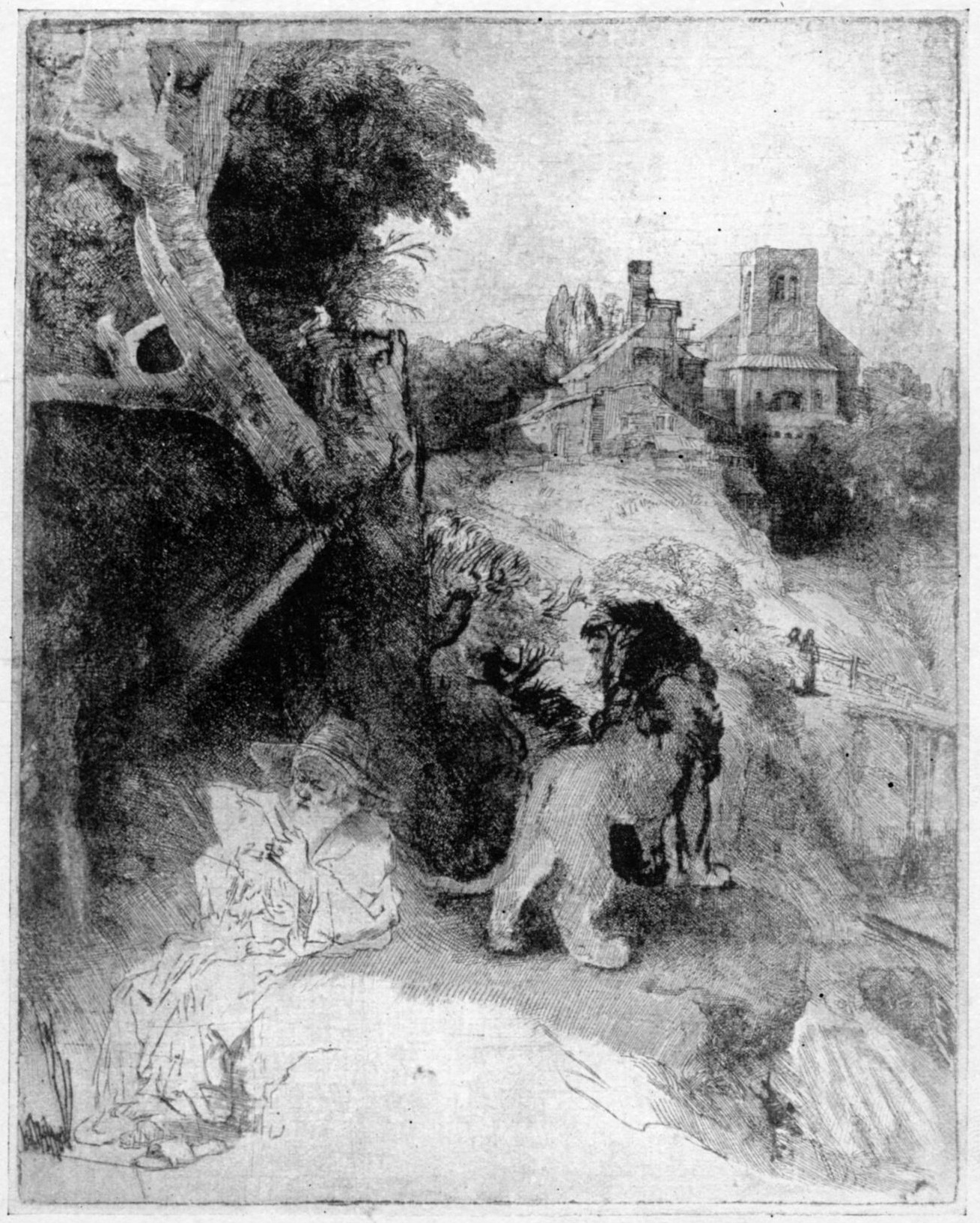
267, I. ST. JEROME READING, IN AN ITALIAN LANDSCAPE. (1653.) B. 104
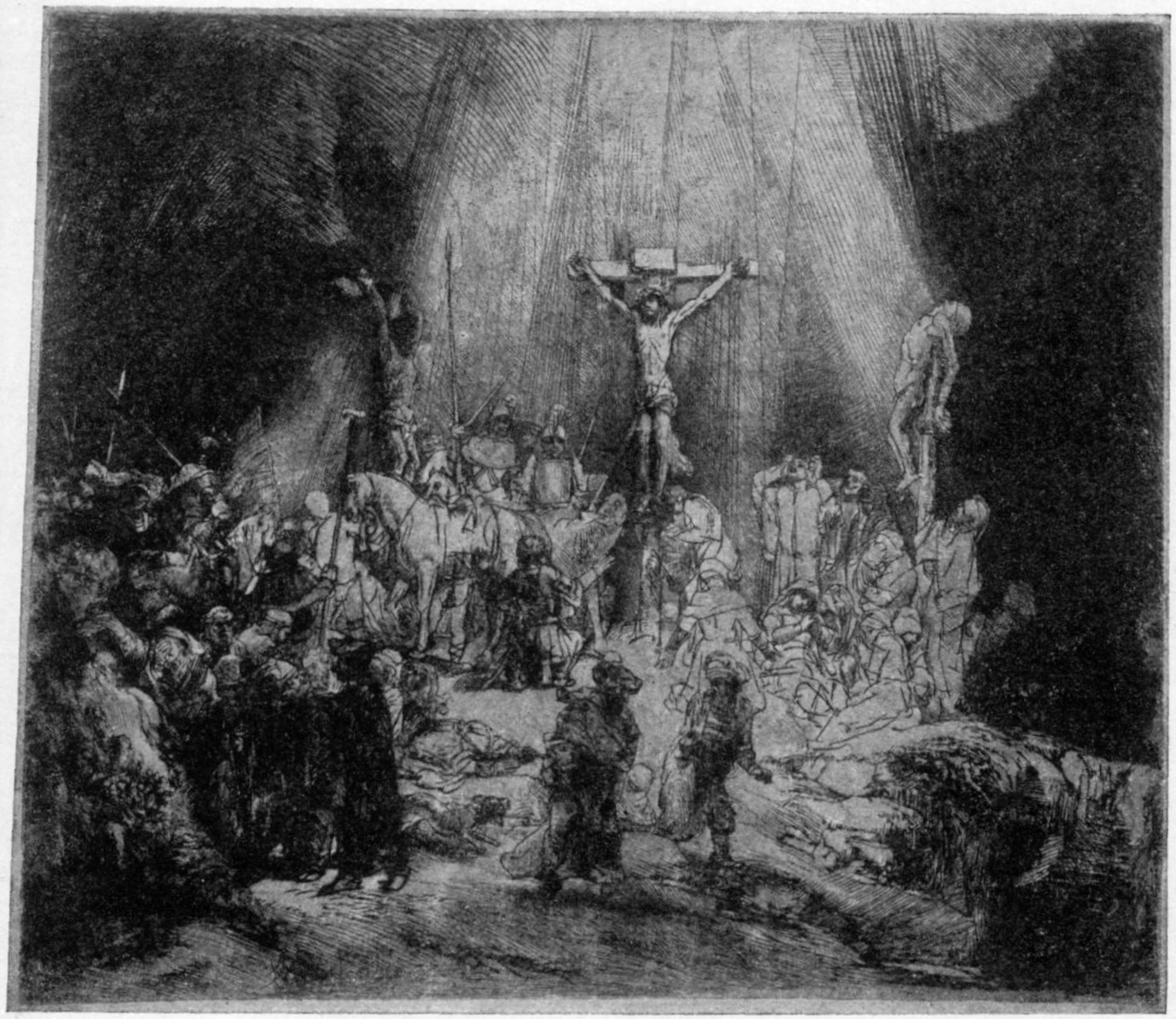
270, I. THE THREE CROSSES. 1653. B. 78. First state
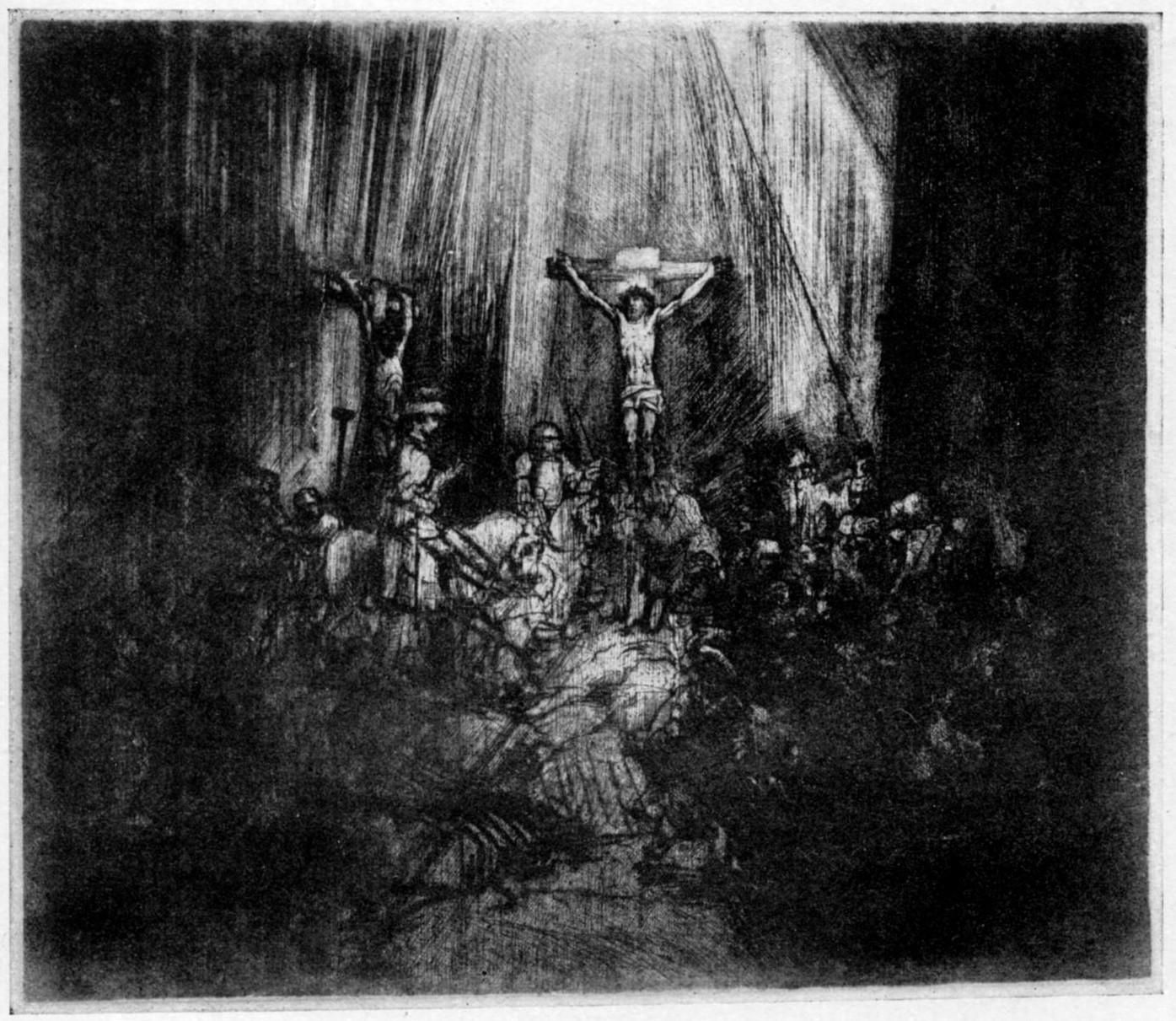
270, IV. THE THREE CROSSES. 1653. B. 78. Fourth state. The plate entirely transformed: ihe figures in the middle and foreground, l., almost entirely effaced; a new group added l. of the central cross,
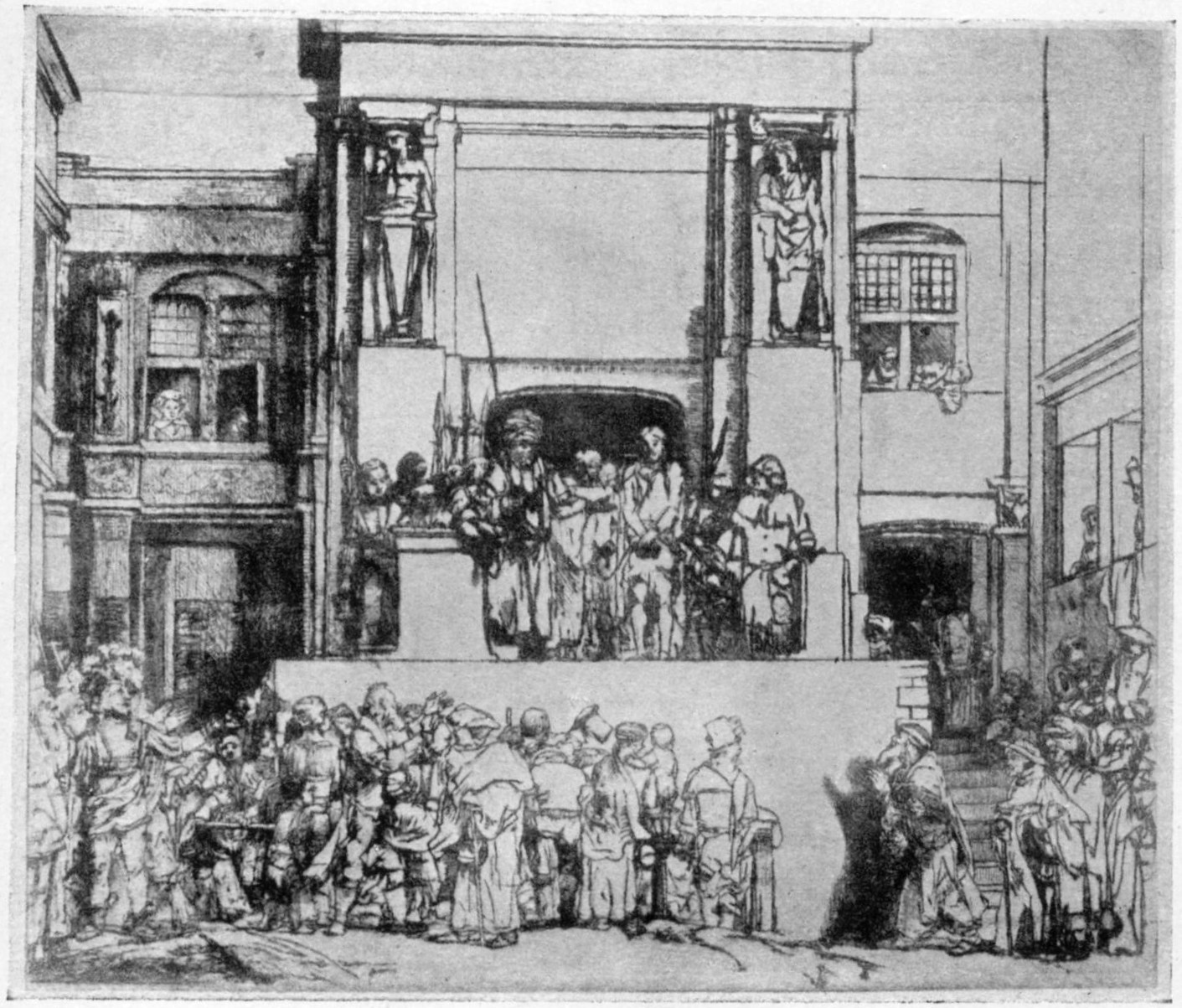
271, I. CHRIST PRESENTED TO THE PEOPLE. 1655. B 76. First state
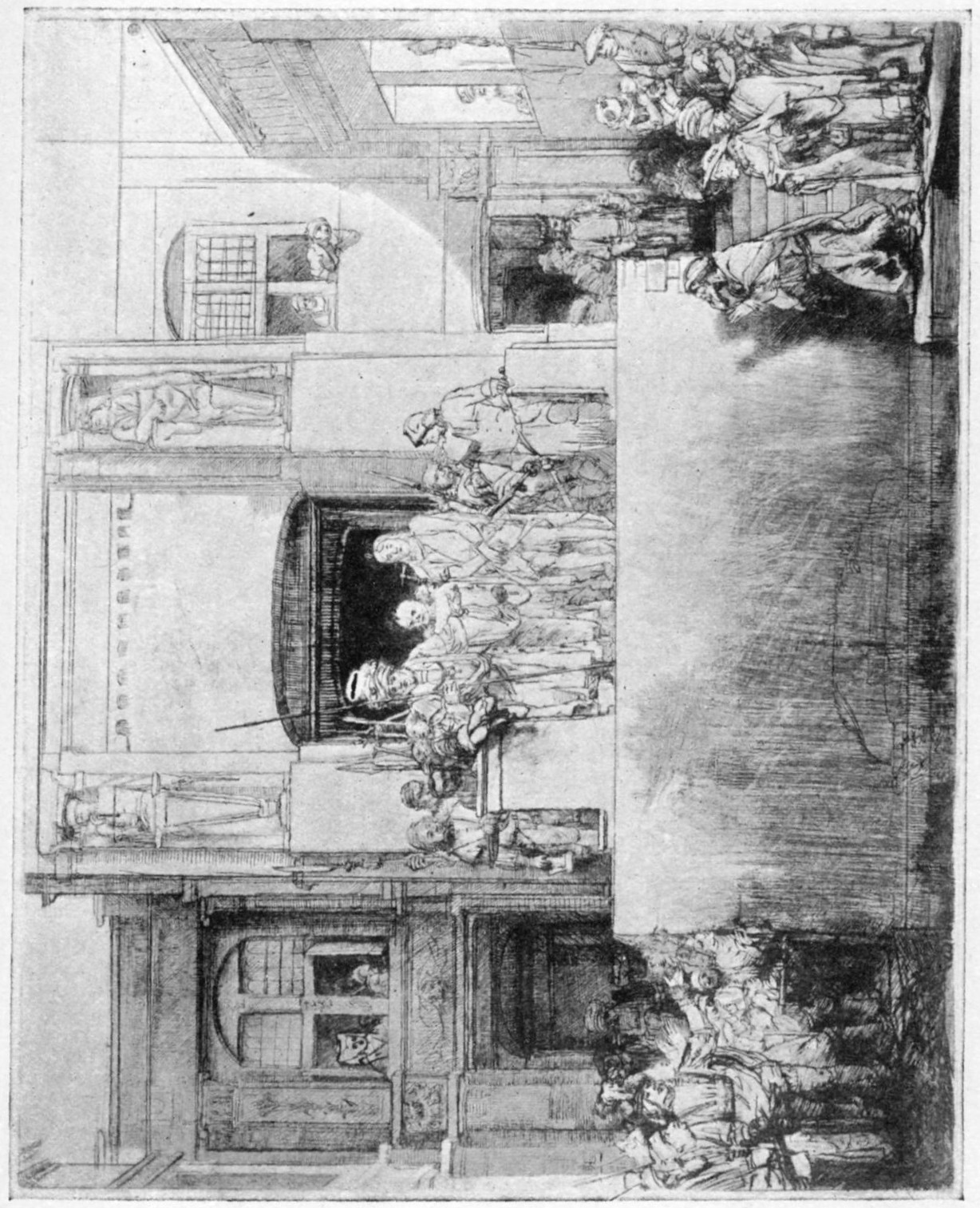
271, V. CHRIST PRESENTED TO THE PEOPLE. 1655. B. 76. Fifth state, all the foreground figures in front of the tribune erased, concentrating the subject on the central figure

275, I. THE VIRGIN AND CHILD WITH THE CAT. 1654. B. 63
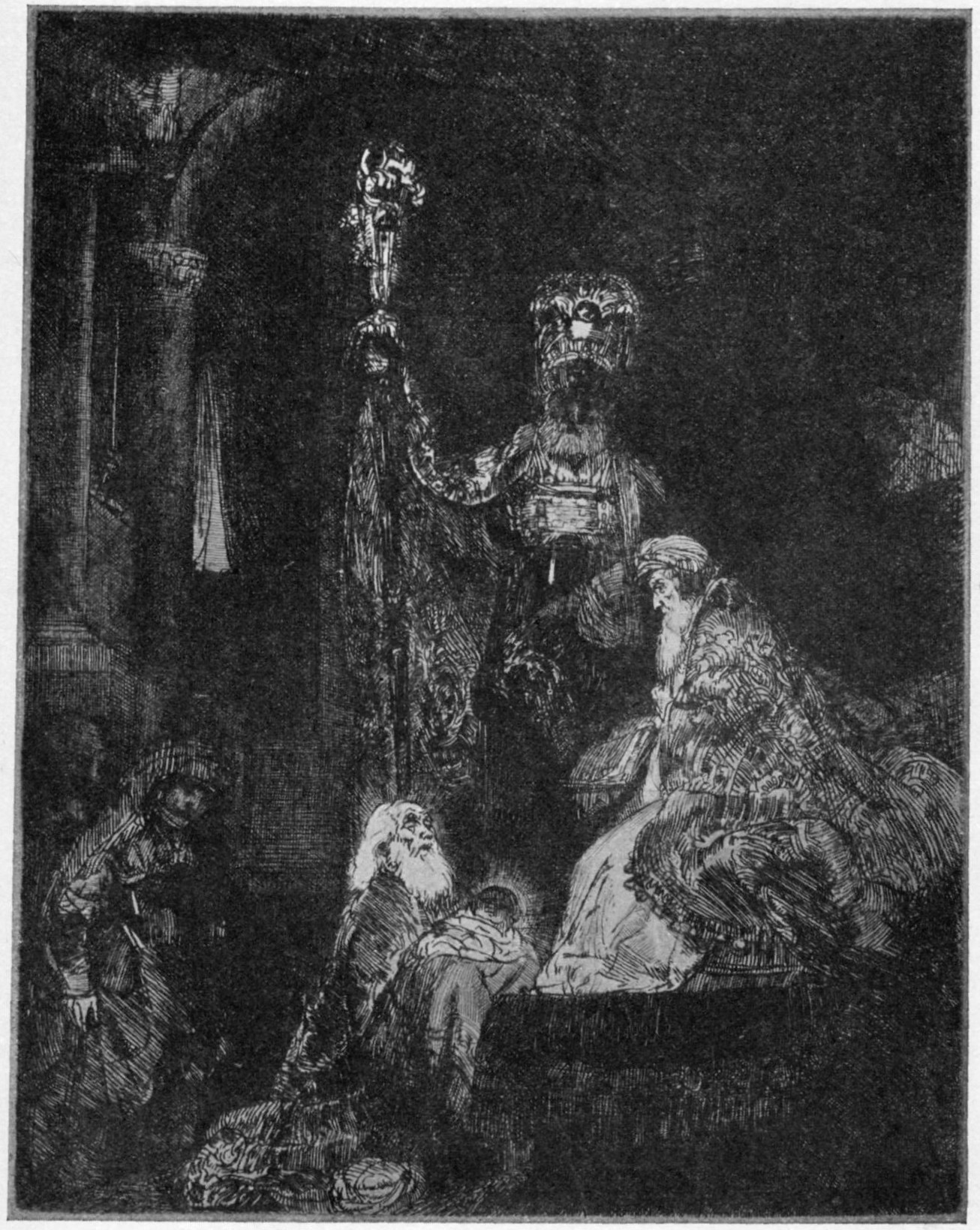
279. THE PRESENTATION IN THE TEMPLE: IN THE DARK MANNER. (1654.) B. 50.
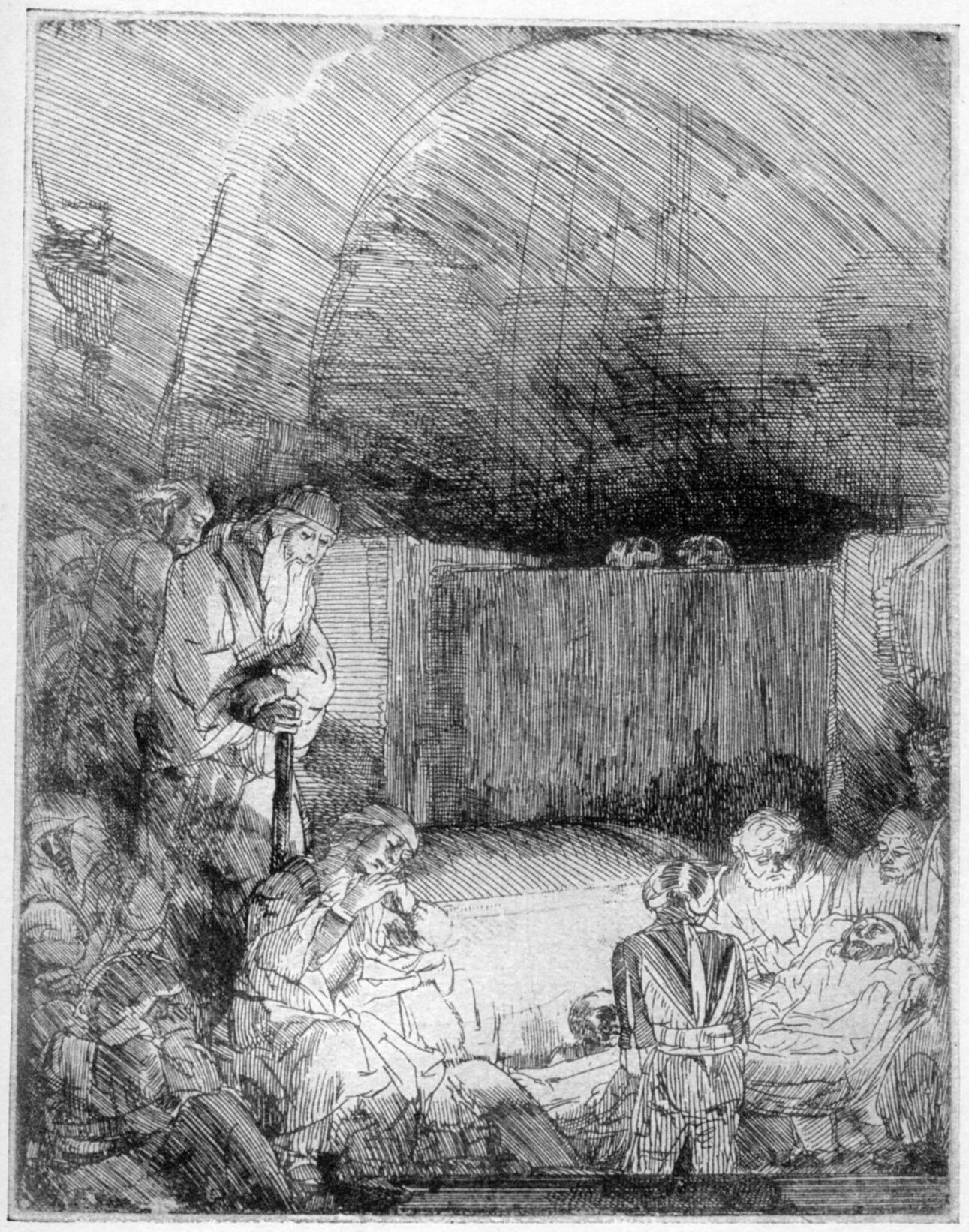
281, I. THE ENTOMBMENT. (1654.) B. 86. The Print is greatly darkened in its later states
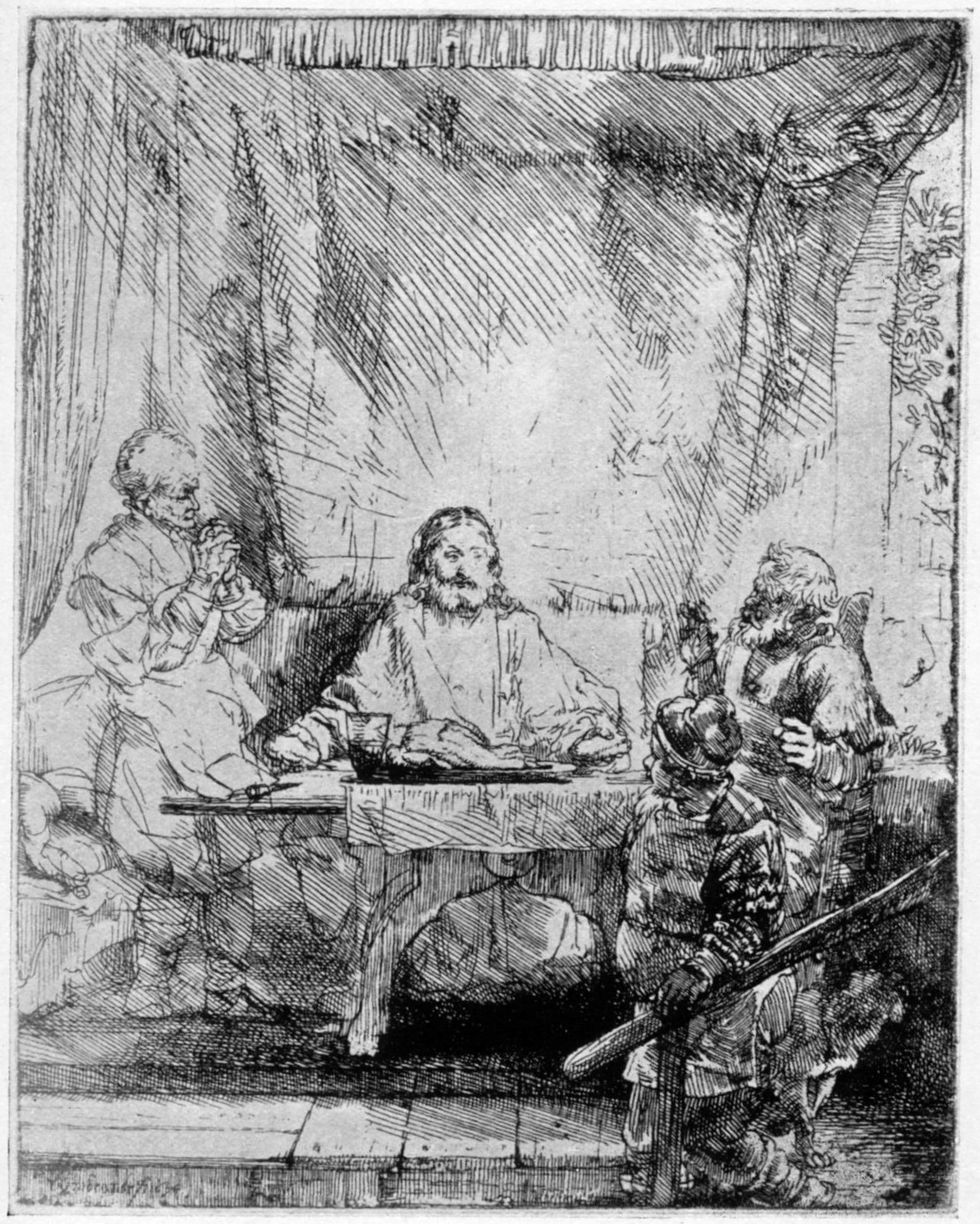
282, I. CHRIST AT EMMAUS: THE LARGER PLATE. 1654. B. 87
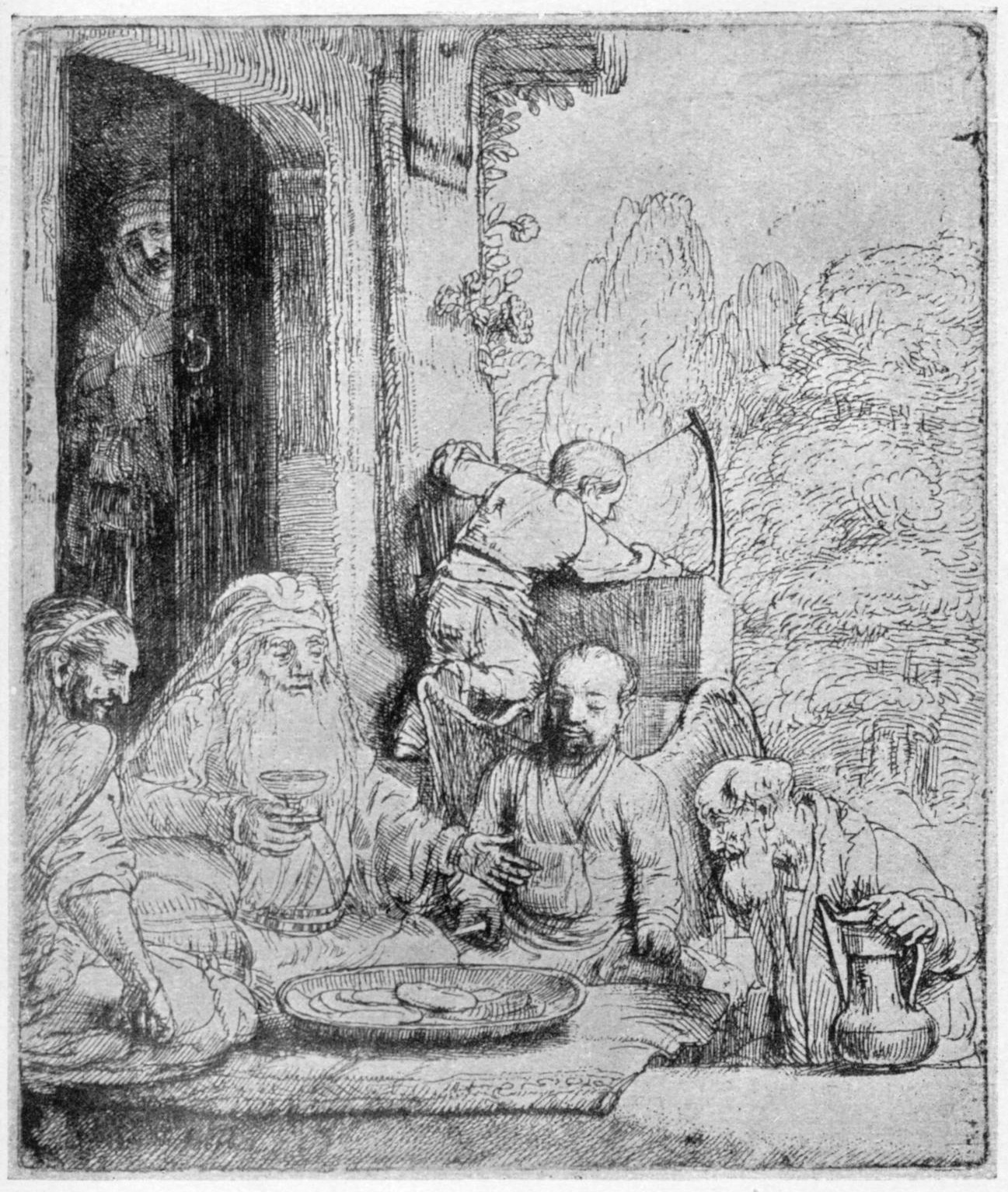
286. ABRAHAM ENTERTAINING THE ANGELS. 1656. B. 29
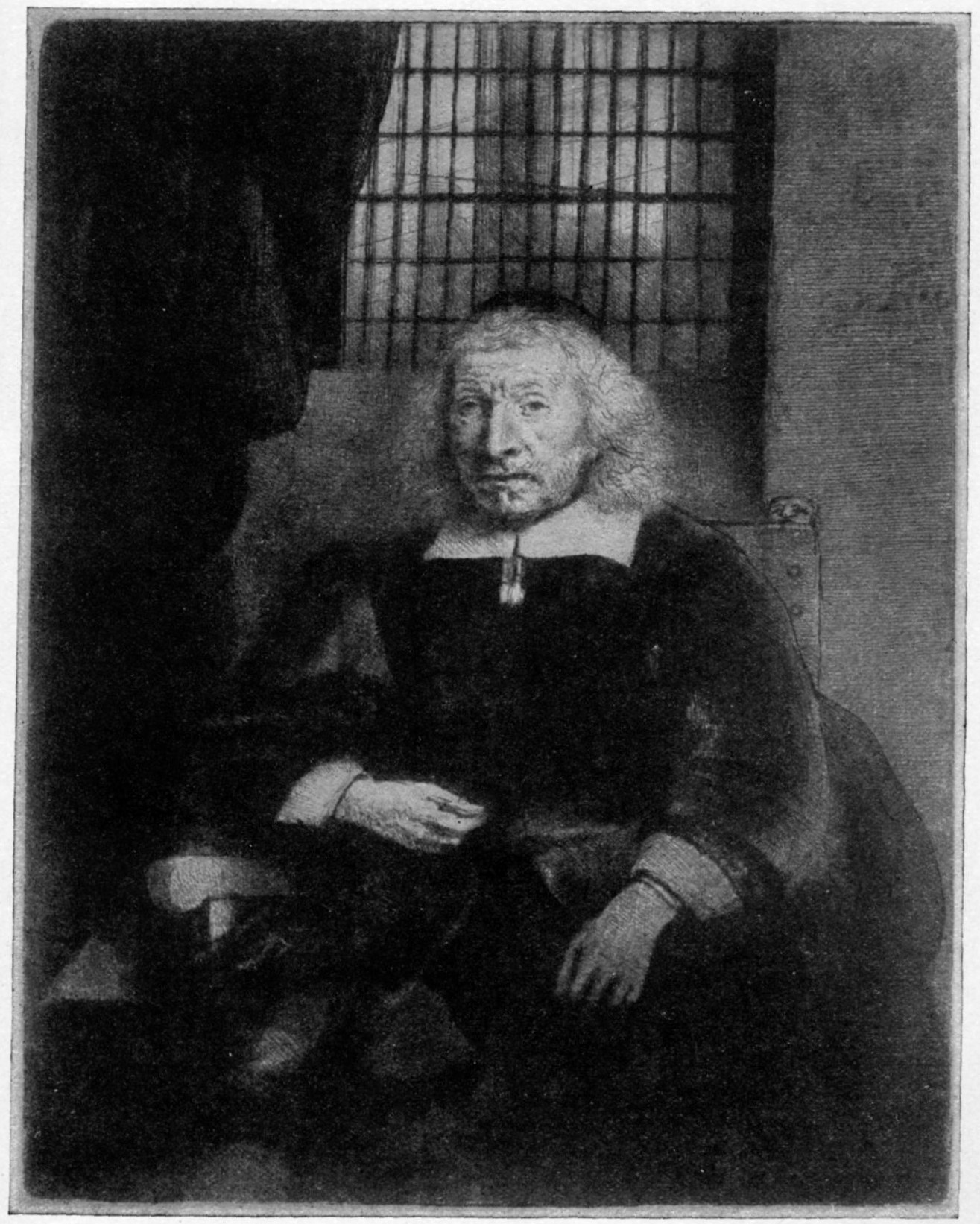
287, II. JACOB HAARING (THE “OLD HAARING”). (1655.) B. 274
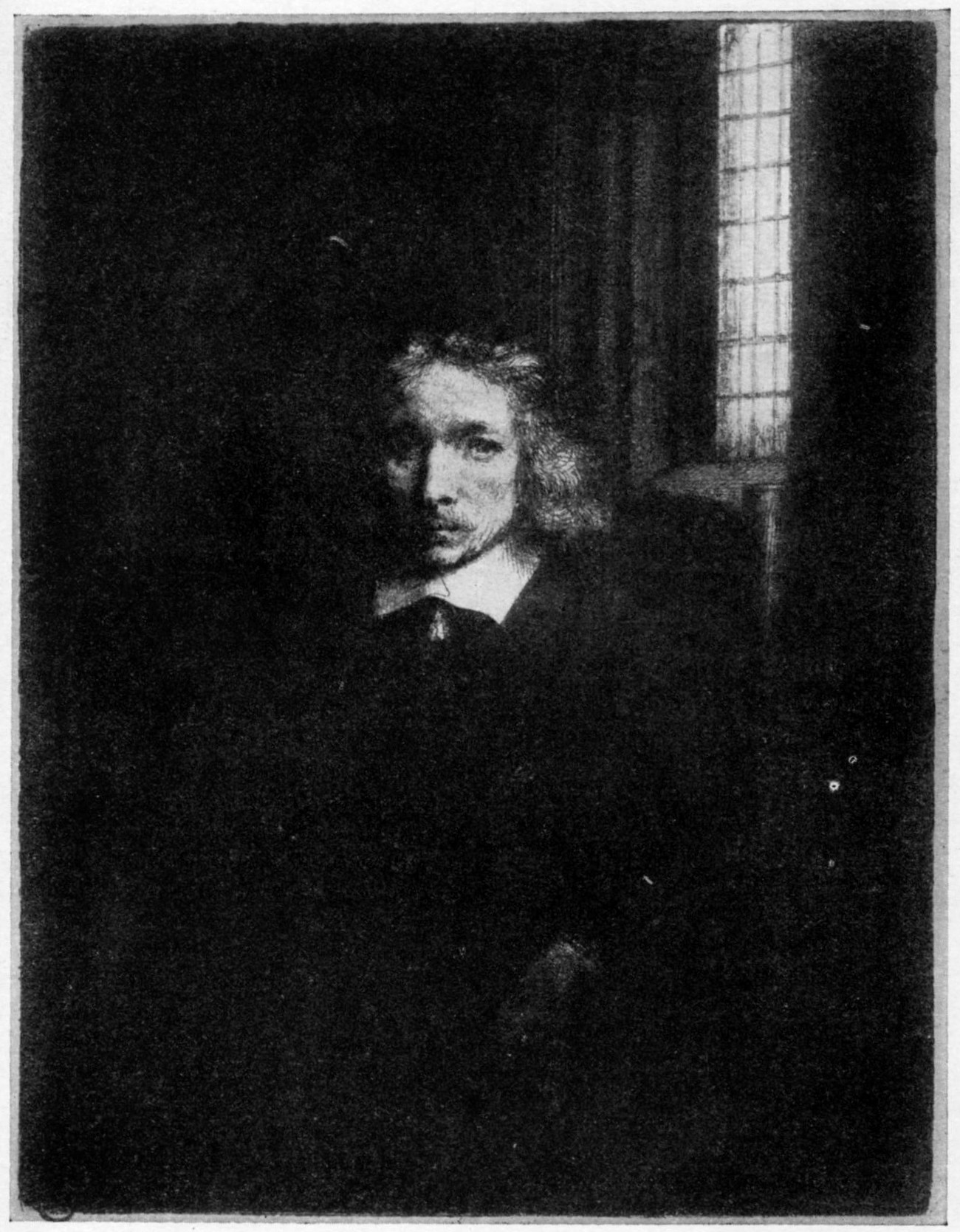
288, I. THOMAS JACOBSZ HAARIXG (THE “YOUNG HAARING”). 1655. B. 275

289, I. ARNOLD THOLINX. (1656.) B. 284. This first state, before the addition of further lines of shading on the breast, is only known in two impressions (British Museum, and Baron Edmond de Rothschild, Paris)

290, I. JAN LUTMA, THE ELDER, GOLDSMITH AND SCULPTOR. 1656. B. 276. First state, before the addition of a window in the background

303, I. THE WOMAN WITH THE ARROW. 1661. B. 202
PRINTED AT THE BALLANTYNE PRESS LONDON
Artist Index ==--==--== |
==++==++== |